Performance report
Published 19 July 2018
Applies to England and Wales
HM Land Registry at a glance
Our ambition
HM Land Registry is committed to becoming the world’s leading land registry for speed, simplicity and an open approach to data, and aiming to achieve comprehensive registration by 2030.
Our mission
Your land and property rights: guaranteed and protected.
Our primary role
We register ownership, interests, and mortgages and other secured loans against land and property in England and Wales. In doing so we:
-
provide a reliable record of ownership of and interests affecting land and property
-
provide land and property owners with a title which is guaranteed by the state
-
provide the security for the financial sector to lend with confidence
Our values underpin everything we do
-
We give assurance
-
We have integrity
-
We drive innovation
-
We are professional
Our statutory duties
HM Land Registry was established in 1862. We are a non-ministerial government department, an executive agency (since 1990) and a trading fund (since 1993) that makes no call on funds voted by Parliament.
The Land Registration Act 2002 empowers us to deal with “the business of registration” and is our primary governing statute. Our income from fees covers all of our costs under normal operating conditions.
The head of HM Land Registry is the Chief Land Registrar, appointed under statute by the Secretary of State for Business, Energy and Industrial Strategy (BEIS) who has Parliamentary responsibility for HM Land Registry and for the legislation under which we operate.
The Infrastructure Act 2015 enabled HM Land Registry to undertake new services that would further improve the conveyancing process or benefit the wider property sector.
Our ambition to become the world’s leading land registry for speed, simplicity and an open approach to data was announced by the Government in February 2017, which was followed by the publication of HM Land Registry’s Business Strategy for 2017-2022 in November 2017.
Our services
Since 1862 we have provided trust and confidence to owners and buyers in the property market of England and Wales by safeguarding ownership and interests in land and property through our expertise in compiling and maintaining an accurate record of who owns what. This register of property ownership, valued at over £4 trillion, is underwritten by an unlimited guarantee which enables approximately £1 trillion worth of personal and commercial lending to be secured against property. Registration of mortgages and loans underpins the financial sector and supports economic growth and prosperity.
Critically we also provide property information that influences the decisions of property buyers, sellers and legal and financial institutions. Solicitors and conveyancers come to us on behalf of their clients to search our records to find out as much as possible about the property.
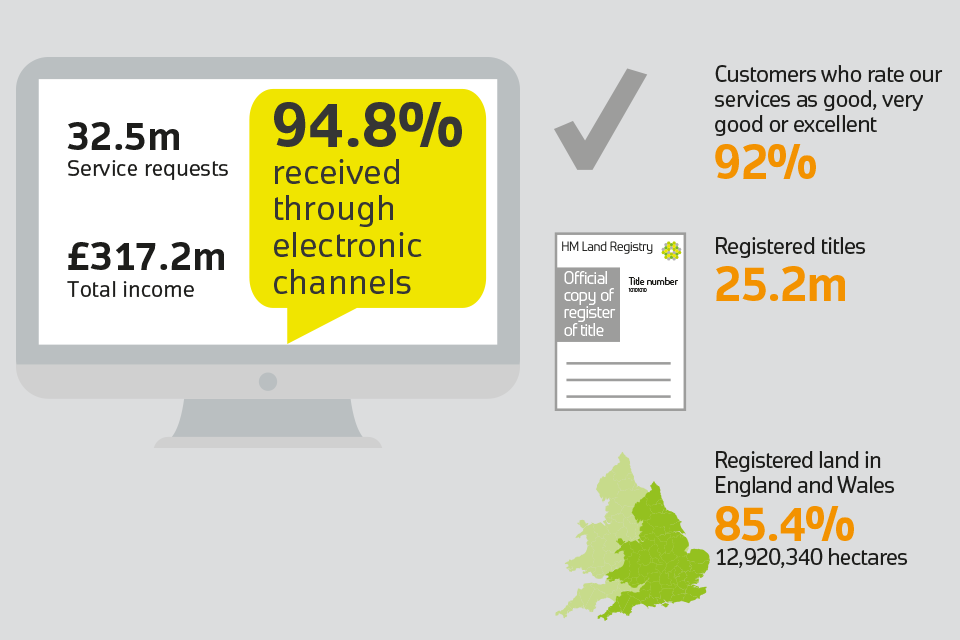

Register change services
When things change the register needs to be accurate. Properties are sold, homes and office buildings are remortgaged, owners get married or property is transferred when owners pass away. When buildings are split into flats, portions of land are sold on and new developments completed, new titles need to be created. Changing the register can be complex so this is where our expert caseworkers focus their technical knowledge and experience.
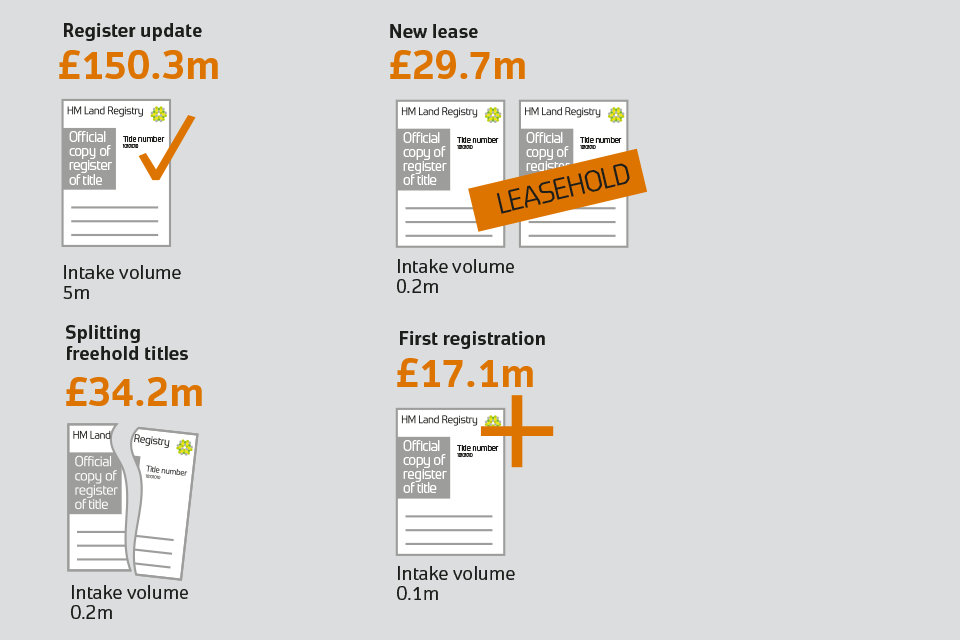
Guaranteed queries
Our registration check, official copies and ‘search and hold’ services provide protection and assurance to property professionals and citizens by protecting transactions while the transfer is completed. These services are largely automated so customers can get their results instantly, making conveyancing faster.
Information services
We hold one of the largest transactional geospatial property databases in Europe and since 1990 our register has been open to the public. Our online services let people check whether a property is registered (without the specific details), check the progress of their request and receive notifications to protect their property against fraud for free. For a small fee anyone can get an instant snapshot of the details for any registered property.

Other services
Our digital Land Charges service protects certain interests in unregistered land and we maintain the bankruptcy index for England and Wales. Our Agricultural Credits Department is responsible for maintaining a register of short-term loans secured on farming stock and other agricultural assets.
The information in our register is valuable to a wide range of users from property professionals and financial institutions through to tech start-ups and infrastructure specialists. Our data, available directly from us or via tech intermediaries, enables property technology (PropTech) entrepreneurs to create new products, allows buyers and lenders to make more informed decisions and facilitates transparency to combat fraud and corruption.
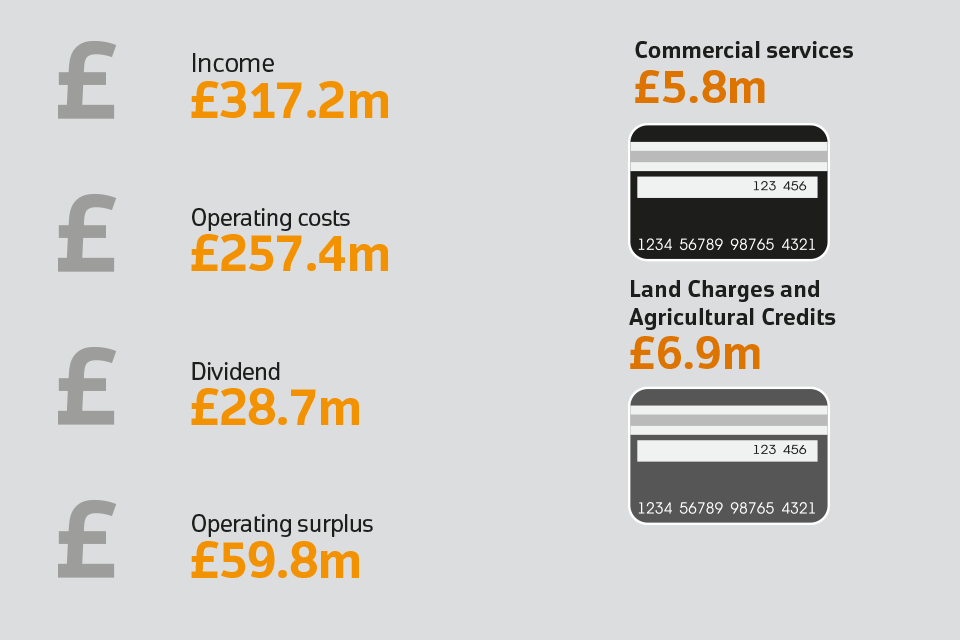
Our strategy
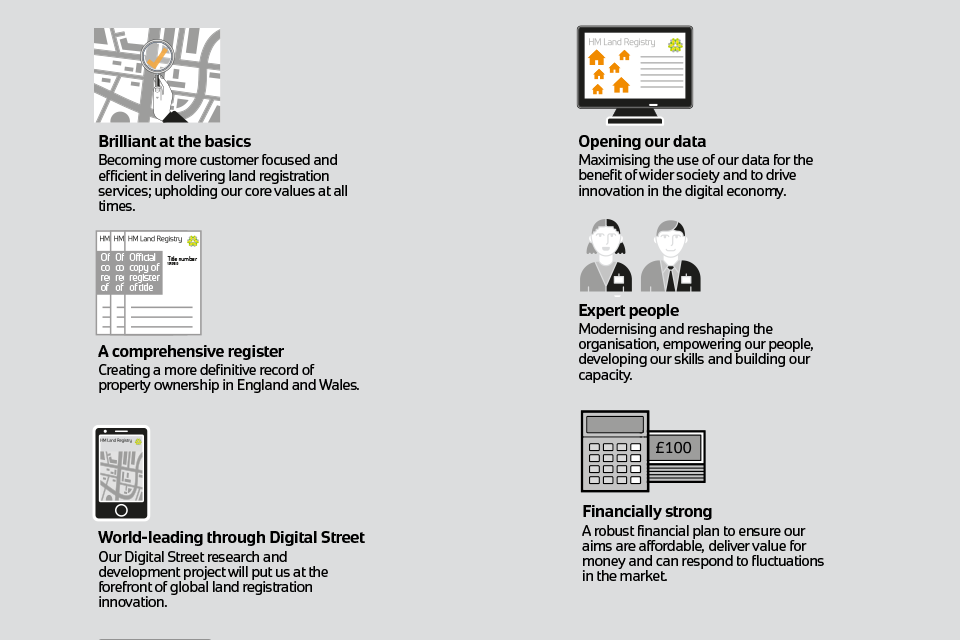
Our role in the property and financial markets
What our customers ask
Looking for a property:
- what’s available close to home?
- how big is the garden?
- how big is the car park?
Arranging a mortgage:
- how much can I borrow?
- what’s the property worth?
Before the exchange:
- is the land registered?
- who owns the property?
- is there an outstanding mortgage?
Exchange of contract:
- is the offer protected?
- has the seller’s conveyancer searched the register?
Completion:
- has my loan been registered?
- has the sale of the property been completed?
Living and working in the property:
- are my details up to date?
- how can I stop myself being a victim of property fraud?
- I need to remortgage
How we help at every stage
Looking for a property:
- register view
- price paid data
Arranging a mortgage:
- land charges search
- house price index
- bankruptcy search
Before the exchange:
- registration check
- official copy
- document view
Exchange of contract:
- search and hold
Completion:
- register update
- register create
Living and working in the property:
- Property Alert
- register updates
Foreword
Statement by Michael Mire, Chair of HM Land Registry

Michael Mire, Chair of HM Land Registry
Our strategy, which we published in November, sets out how we will achieve our ambition to become the best land registry in the world for speed, simplicity and an open approach to data.
Transformation is well underway. ‘Digital Street’ has captured the imagination of lawyers, bankers and companies by defining how blockchain, artificial intelligence and machine learning can revolutionise the property market and make it the most efficient and frictionless anywhere. We have already reshaped the law to enable digital conveyancing and achieved a historic milestone by accepting the first ever digitally signed mortgage in the UK.
The geospatial data in our register underpins Britain’s land and property intelligence. That is why HM Land Registry is a founding member of the new Geospatial Commission through which we will maximise the value of our data by linking it with other government and private sector data to create an unrivalled source of geospatial intelligence for the nation.
Our data is already propelling the growing digital economy through a new wave of PropTech entrepreneurs. This year’s Geovation challenge winners have raised over £1 million worth of investment through reimagining the use of HM Land Registry’s data to create innovative products and services for the property market.
To take us through our transformation we have put together a leadership team including new non- executive board members from FTSE 100 companies, like Aviva and Land Securities, and from technology leaders like Amazon, to sit alongside HM Land Registry’s own expertise from across government to create one of the strongest boards in the public sector.
HM Land Registry is not forgetting the here and now. Our Model Office programme and our new executives are surfacing and tackling inefficiencies in the organisation, reducing bureaucracy and promoting diversity. While customer satisfaction is good overall, only a minority of our customers say it is excellent.
Digital is where the future lies but HM Land Registry is a critical component of national infrastructure today. Unless HM Land Registry functions effectively the residential and commercial property market, and financial institutions whose economics are based on mortgages and other collateralised lending, would be severely impaired. Our new board members, and our new management team, are determined that what we do tomorrow is not at the expense of what we need to do today.
I also know that HM Land Registry is completely dependent on our frontline colleagues whose expertise is crucial to our performance. They do amazing things every day, often using inefficient and outdated systems. The way they are coached and led is sometimes old-fashioned.
I read every blog response and recognise how frustrated many colleagues are. We are putting this right through more effective operational management and new casework systems that ensure our people do not feel they are wasting their skills or wasting their time.
But our strategy also involves radical change. HM Land Registry has the opportunity through new technologies to shape the future of the property and financial markets. When citizens, firms and government buy, sell, lease or borrow against property in future they will have a far simpler and quicker experience.
We are determined as well that all the locational intelligence which customers need during property transactions are available in one place. HM Land Registry is going to be a model of how a public service with public service values at its heart can become a world leader in the digital economy.
Our transformation is therefore not blue-sky. It is grounded in the reality of what HM Land Registry needs to do right away for customers and colleagues. You can read about these important programmes in this Annual Report.

Photo: WeWork
HM Land Registry recorded the grant of a lease to WeWork at 90 York Way in London, one of 24 buildings in London in which WeWork offers co-working space to digital start-ups and, increasingly, to established companies. All its space in London has been recorded by HM Land Registry. WeWork was valued at over $20bn in its last funding round.
Overview
Interview with Graham Farrant, Chief Executive and Chief Land Registrar
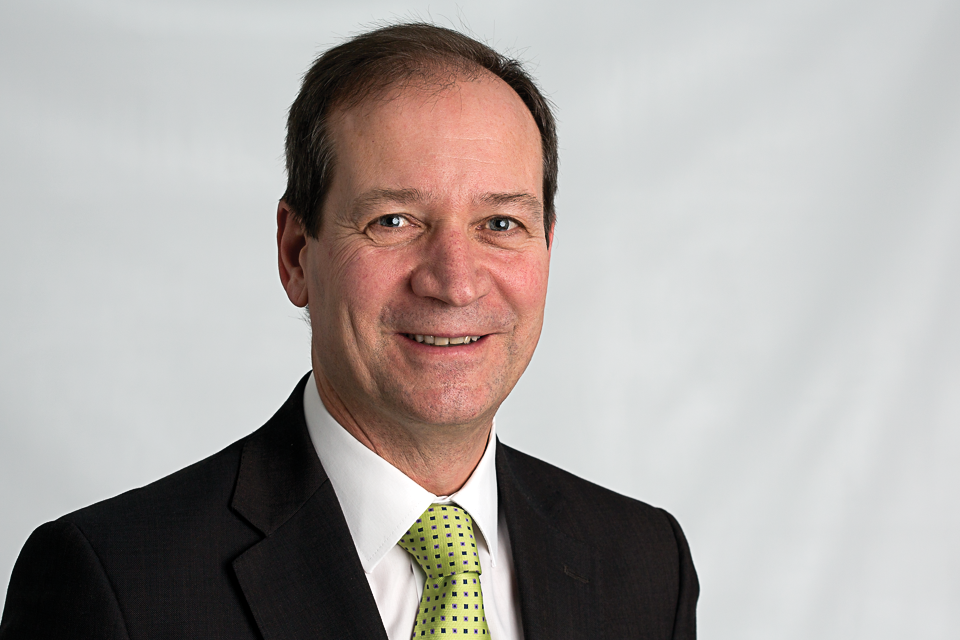
Graham Farrant, Chief Executive and Chief Land Registrar
Has the past year been a successful one for HM Land Registry?
Yes, I would definitely say HM Land Registry has had a successful, and in many ways a milestone, year.
We delivered 10 of our 11 key performance indicators with record results for casework quality, colleague engagement and leadership. The one key performance indicator we missed was our speed target for registering new titles, but we hit our speed targets for all other types of applications and our information services.
We also made significant improvements to our processes for complex cases and reduced our timescales significantly, meaning we only narrowly missed this year’s target and are well on course to deliver our target for next year. Our customers have recognised our improvements with a 92% satisfaction rating, all while we are delivering new data products and digital initiatives to support our transformation.
We have continued to invest in the development and progression of our existing expert colleagues, as well as recruiting high calibre people into HM Land Registry. I was honoured to sign and present over 100 long service awards to our loyal and dedicated land registration experts who have spent more than 40 years with us.
We continue to emphasise our purpose, which is why our 2030 target to achieve comprehensive registration is so important. Comprehensive registration of land and property interests in England and Wales was our original purpose back in 1862. It took almost 100 years to register the first million titles but as we turned 155 years old we marked the milestone registration of our 25 millionth title and reached the landmark of 85% of the land mass now being registered.
Can you pick out one highlight from this year?
There have been so many highlights, from the awards we have received through to the first mortgage being digitally signed and the graduation of our apprentices who will be the future of our organisation. However, I think the main highlight for me was launching our five- year Business Strategy.
Last November at our annual stakeholder event, our Minister, Lord Henley, and I proudly announced our ambitions for HM Land Registry to our stakeholders against the historic backdrop of the Royal Society in London.
Our strategic intent to make conveyancing simpler, faster and cheaper by becoming the world’s leading land registry for speed, simplicity and an open approach to data was warmly welcomed by all and our plans for comprehensive registration to support housing development were already well understood.
How did people react to the five-year Business Strategy?
Being able to publish an ambitious strategy that gives genuine clarity about how we will deliver on our mission and our values was incredibly powerful for our colleagues, our customers and our stakeholders.
I regularly meet with our stakeholders and our customers and they have all supported what we are doing, but maybe that is because we consulted extensively with them in developing the new strategy.
For our colleagues we had been openly talking about our strategy as we were developing it, taking account of their experience and knowledge of land registration, so it was no surprise when our first internal survey showed that colleague awareness was at 83% and understanding was at 75%. Our strategy has been downloaded thousands of times but I would like those internal indicators to be even higher so the directors and I will be spending more time talking to our colleagues to make sure they understand every element of our plans.
What are the highlights of the strategy?
We have a very clear remit set out in our strategy and our main focus will be to ensure we are brilliant at the basics of land registration, but we are also leading the industry through new digital services such as Local Land Charges, pioneering research through Digital Street and the release of new datasets. We want to work alongside our partners and stakeholders to move forward on adopting digital technology to change the way people transact with property.
Our profile is definitely growing. Whether it is requests for media interviews, speaking opportunities or invitations for wider collaboration across the property sector, it certainly seems that our aims and ambitions are more widely known and understood than ever before. I have even had stakeholders quoting our ambition back to me as they suggest further changes that we could support across the conveyancing industry.
People are excited to work with us, and for us, because we have a truly exciting agenda they want to be part of.
Do you have the right team to successfully transform HM Land Registry?
This year our focus has been to ensure we have the right people in place, and the capacity to fully deliver our ambitions in line with our strategy.
We have welcomed a new team of executive directors, non-executive board members and deputy directors who bring a wealth of experience from across a varied and impressive portfolio.
However, it has not just been about refreshing the senior management. As part of a strategic workforce plan we have welcomed over 600 new colleagues into the organisation at all levels, including apprentices.
We have also invested in the development of our colleagues’ skills and empowered them to deliver change by giving them the space and freedom to innovate and operate.
How have you managed the impact of change with colleagues?
All of this has been delivered as part of our new People Strategy, which underpins our Business Strategy. Our people-focused change framework really helps to implement change in a constructive and supportive way with our casework and support teams.
Our dedication to the people outcomes of transformation has been recognised with a Public Services People Managers Association (PPMA) award for Sustainable Transformation and a personal award for our HR Director, Caroline Anderson, who won the prestigious PPMA award for Public Sector HR Director of the Year.
Overall, we have had a great year and we have delivered a lot of change, but we know we still have a long way to go. As a Board we know that none of this would be possible without the dedication and professionalism of our colleagues across every part of our organisation.
In casework and support services our colleagues have gone the extra mile to deliver against an ambitious plan for the future.
What are you most looking forward to over the year ahead?
Our primary focus will always be the delivery of core land registration services as that is central to our pivotal role in the property and financial markets. Along with a continued focus on operational excellence we will be seeing our transformation continue as we enhance and expand our digital services, release more data and improve our customer service to make the conveyancing process simpler, faster and cheaper.
We also are keen to start work with the Geospatial Commission. We are one of six initial government bodies working together with the new commission to maximise the value of all UK government data linked to location, and to create jobs and growth in a modern economy. An open approach to data is a key ambition for us so I am excited about what we can achieve together.
I am also really interested to see how the next cohort of PropTech start-ups fare as part of the Geovation programme we run jointly with Ordnance Survey. By providing our support, funding and access to our data HM Land Registry is really helping these new businesses grow and provide interesting and innovative new products into the emerging digital market. Our first round of three start-ups have all received further investment totalling more than £1 million so it will be a good challenge to see what we can do to help our new round of start-ups to live up to their success.
So on the back of a good year and the launch of our new Business Strategy I want to set even higher expectations for the future. We will continue to progress and to change the way we work, alongside stakeholders and partners, to make conveyancing faster, simpler and cheaper and move HM Land Registry towards being the world’s leading land registry for speed, simplicity and an open approach to data.

Media City. Photo: Knight Knox
Media City, Salford: X1’s Media City Tower 1 is the first tower built as part of the Media City development that is already home to buildings for BBC and ITV television. This includes one of the largest mixed- use developments in the north-west of England and its silhouette dominates the Salford Quays skyline. The four distinctive towers will comprise a mix of apartments, commercial and retail units, with underground parking alongside an on-site gym and cinema. We quickly developed an effective working relationship with the solicitors to obtain site layout information to enable us to plan for the registration. This enabled us to resolve any issues up front and develop standard register creation processing instructions to enable our most junior colleagues to process the work. As well as being cost effective for HM Land Registry this pre-planning and engagement enabled improved customer service.

BBC Television Centre. Photo: BBC
BBC Television Centre, White City, London: The regeneration of the former BBC Television Centre will provide more than 900 homes, offices for the creative industries and a wide range of leisure facilities including a hotel, health club, restaurants and cinema. Our Plymouth Office is registering the leases.
Our Non-Executive Board Members
Diana Breeze
Diana is the Group HR Director of Land Securities Group where she is a member of the Executive Committee and attends Investment, Remuneration and Nominations Committee meetings. Prior to this, she was Director of HR (Corporate) at Sainsbury’s, after a period in consulting with Accenture, where she specialised in organisational design and development. Diana began her career on the graduate programme of the John Lewis Partnership.
“HM Land Registry has created a very aspirational and ambitious agenda for itself – radically streamlining its processes in the short term, while harnessing the latest new technology to transform them in the medium to long term. That’s pretty exciting and will require the workforce to not only learn new skills but to build further upon the deep expertise and embedded customer service ethos that it already has.”
Kirsty Cooper
Kirsty is Company Secretary and General Counsel for Aviva, the UK’s largest insurer, where she has more than 25 years’ experience at Aviva. She established the legal and secretarial function as a global team and her responsibilities include the provision of legal services, company secretarial services, public policy and corporate responsibility. Kirsty is a member of the Board of Trustees of the Royal Opera House and has previously served on the Board of the English National Ballet. In 2016 and 2017 she served as a member of the Dormant Assets Commission, which reported to Government in March 2017.
“HM Land Registry has a rich heritage, but I am impressed with its focus on the future. I have a legal background but want to bring in a customer perspective, appropriate challenge and a long term vision for making the most of this vital organisation.”
Doug Gurr
Doug is Amazon UK Country Manager. He joined Amazon in 2011 and was President of Amazon China from 2014 to 2016. Prior to Amazon, Doug was a senior executive and board member at Asda after founding his own tech start-up and working as a Partner at McKinsey & Co. Doug has two degrees in Mathematics from the University of Cambridge, and a Doctorate degree in Computing from the University of Edinburgh. Outside work, Doug is Chairman of the British Heart Foundation and in his spare time has completed 12 Ironman triathlons.
“It is an opportunity to help support a radical digital transformation in the public sector, delivering digital services in a very traditional industry.”
Angela Morrison
Angela is the Technology and Supply Chain Director for Debenhams. Angela has executive committee experience at two FTSE 100 companies, as the Chief Information Officer for Sainsbury’s and then for Direct Line Group. At Direct Line, Angela led the migration of Direct Line’s system from Royal Bank of Scotland (RBS) and the development of their corporate social responsibility strategy. For the last 11 years Angela has sat on the Advisory Board for The Tech Partnership (previously E-skills), working with peers and counterparts in the information technology (IT) service sector to improve IT skills in education and the workplace.
“I want to offer my experience of system-enabled business transformations, as people and process are critical to the success of any new system. It’s the opportunity to be part of a significant digital transformation of an organisation that is the backbone of the UK. Literally!”
Chris Morson
Chris has spent much of his executive career in financial services. Most recently he has specialised in digital transformation at scale, as Managing Director of the digital business of RBS/NatWest and then at Virgin Money. Chris is also a Non-Executive Director at the Money Advice Service and the Driver & Vehicle Licensing Agency.
“I wanted the chance to work on transforming HM Land Registry into an organisation that will revolutionise the way individuals and businesses transact in property – to make it so much simpler, faster and better. Plus, it’s a great opportunity to make the UK a world leader in this area. What’s not to love about that?”
Claire Wren
Claire is a member of UK Government Investments (UKGI) and represents the interests of the Secretary of State for Business, Energy and Industrial Strategy. Prior to joining UKGI she worked at HM Treasury for nine years on a range of issues including industrial strategy, migration, establishment of the Asian Infrastructure Investment Bank and (separately) establishment of the Office for Budget Responsibility. Before joining HM Treasury she worked at a think tank researching the role of Parliament in foreign policy. Outside of work she has been a board member of a housing association for 12 years.
“I am there to help ensure a strong link between HM Land Registry and wider government. This is particularly important as its work is relevant to a range of government interests from effective mortgage markets to housebuilding.”
Brilliant at the basics – by design
Chris Pope, Chief Operations Officer

Chris Pope, Chief Operations Officer
The operations of HM Land Registry are a demanding balancing act. On the one hand there is the skilled processing of changes to millions of entries in the register which are critical to the smooth functioning of the property market. On the other hand, we need to transform and improve the way we operate.
We began the year with a significant backlog of register create applications. The average age of these applications from receipt by HM Land Registry was 34.4 days.
Despite a year with higher service demand than in recent years, the average age of register create applications is now down to 26.3 days and we have reduced our backlog by more than 50%. But these improvements have not been achieved at the cost of quality or service. Our customer satisfaction scores, which had previously dipped reflecting particular concern around our speed of service, now exceed our target, and the quality of our work is at a record high.
We devoted considerable resources to improving our operational performance supported by the commitment and ideas of our caseworkers with more than 500 apprentices and registration officers arriving during 2017/18, training and further enhancing the skills of our experienced colleagues.
However, missing just one critical target highlights the importance of why we need to make changes. We know that eventually new digital systems will transform our work. But without changing now we risk digitising existing processes rather than becoming brilliant by design.
To be brilliant at the basics we are redesigning and reshaping how we are organised for operational delivery, delivering sustainable benefits in the short term while supporting further digitisation in the future.
Improving our customers’ experience
Our changes have not just been about improving the efficiency of our internal operational processes but also improving the experience for our customers. As a result, our customer satisfaction scores have risen to 92% exceeding the target of 90% we set ourselves at the beginning of the year.

We are finalising our new Customer Strategy and have already started making changes to improve our customers’ experience.
We process hundreds of thousands of service requests every month so there is often a need for customers to contact us. Customers used to have to call individual teams at specific offices on over 100 different phone numbers and this became a cause of frustration.
This year we centralised customer service into a Customer Support Centre, split between our Swansea and Durham offices. Teams include experienced land registration experts so they are able to handle most queries efficiently and promptly. They refer queries on to case owners only where necessary so they can focus on applying their skills, expertise and judgement on processing new applications. We will be developing our Support Centre colleagues’ customer skills and investing in new technology to ensure we provide the level of service our customers expect and deserve.
While the vast majority of our work involves more straightforward updates such as remortgaging or transferring ownership, some customers’ needs are very different from the standard conveyancing process.
Larger-scale home builders and infrastructure providers have registration needs that are complex, require more consideration and need greater expertise than register updates. To support developers we have created expert teams to assist with their land acquisition decision making and estate planning. Examples range from HS2 to the transformation of the former Hendon Police College site into a large-scale residential development.
By standardising the work associated with site acquisition, plot processing instructions and training paths, we have a more fluid system and more consistent outcomes for our customers. We are exploring ways we can further digitise the process and how additional digital services can improve the experience even more.
HS2 – our biggest ever infrastructure project
High Speed 2 (HS2) promises to be the biggest infrastructure registration project in our history. We are making sure that the ownership of new assets is crystal clear. This is a huge undertaking as more than 30,000 interests for property details for nearly 350 miles of route, connections and depots will be delivered over the next ten to twelve years.
An expert team based at our Swansea office will smooth and simplify the conveyancing process for this high-profile national project. Drawing on expert experience gained from similar projects such as High Speed 1 and Crossrail, a core of senior caseworkers and lawyers will be joined by other colleagues as the work increases.
We have laid the groundwork through a series of meetings with the HS2 team and their representatives to discuss the registration process and agree what our approach will be in complex areas such as easements and restrictions.
“We have built a strong relationship with the HS2 team,” said Senior Caseworker Kevin Barry. “We have started to receive the first applications, mainly relating to sites around Euston Station in central London, and we will see a significant increase as HS2 acquires the land between London and Birmingham as part of Phase One of the HS2 scheme. Our task is to make delivery of HS2 as seamless as possible.”
Getting things right first time
Currently 20% of all applications require further enquiries to seek clarification or request missing information. New and improved digital services will reduce the potential for these mistakes to occur but there will always be areas where errors or wasted work can occur, so we will work with our customers to help them know what, and when, they need to submit so they can get it right, first time, every time.
Reducing the number of application enquiries will reduce the overall cost of conveyancing, enable our colleagues to process applications faster and ensure customers and businesses are getting the best value for money for the professional services they pay for.
We have started sharing data with some of our customers, so they know more about the application enquires we are making with them. We are working with stakeholders in the industry such as membership bodies and regulators to publish customer performance data. This transparency supports our wider ambition for an open approach to data and enables us to work across the industry to improve error rates and information gaps.

Design Museum. Photo: Design Museum/Gravity Road
Design Museum, London: The former home of the Commonwealth Institute stood vacant for over a decade before it was transformed into a building fit for a 21st century museum while retaining some of the key architectural features of the building including the Grade II listed distinctive copper roof. The lease was registered by our Fylde Office.

Colindale Gardens. Photo: Redrow
Colindale Gardens, London: More than 3,000 residential and commercial plots form 24 phases of development over the next 10 to 15 years at the Hendon Police College site. Our experts made recommendations to the developer on the creation of multiple parent titles and gave guidance on requirements which have enabled the conveyancing process for subsequent house sales to be simpler, faster and cheaper for all parties.
Dealing with complaints
We treat customer complaints seriously in HM Land Registry.
We recorded 2,712 complaints in 2017/18 compared with 2,464 in 2016/17. The overall proportion of upheld complaints was 42%.
Our Independent Complaints Reviewer (ICR) provides a free and impartial review and resolution service for any customer dissatisfied with how we have handled their complaint. As well as making recommendations to us about individual customers they also propose actions to improve our practice and procedures to reduce the risk of making the same mistakes again.
Copies of every ICR report are forwarded to a committee of senior colleagues to consider any findings. Where complaints are upheld, the Chief Executive writes directly to the customer to apologise and explain what we will do to put matters right.
Model Office – where our colleagues make us more efficient
Angie Clarkson, Deputy Director, Registration Services

Angie Clarkson, Deputy Director, Registration Services
Core registration services are undertaken across all 14 of our locations, involving more than 3,500 colleagues. Workload types, volumes of work, colleague numbers, grade and skills mix and team structures vary by location so while historically all locations complete a range of core registration work, no two offices are organised in the same way.
This year we have been investigating how we can work more efficiently, effectively and consistently through our Model Office continuous improvement initiative.
Durham and Plymouth colleagues have been testing and implementing a range of new ways of working including new structures, processes, roles and responsibilities. Ideas come from the frontline who have embraced the ‘agile’ principles from our digital colleagues; if new ideas fail, they quickly move on and try something else. Successful ideas that increase productivity, drive efficiency, improve effectiveness and support colleague engagement are then rapidly rolled out and adopted across the organisation.
By empowering our experts to identify, test and shape how they work we not only improved our outputs but we are creating a culture of positive disruption and innovation. Next year we will be building on the work to standardise manual processes, redesigning the way work is allocated to colleagues, and looking at the digital tools and systems caseworkers use every day. Working closely with our digital colleagues we are focusing on those processes which are unlikely to be fully automated in the short to medium term, maximising the value of the productivity gains.

Durham Castle and Cathedral. Photo: Travelight
Durham and Plymouth colleagues improve work allocation
A trial approach to managing the allocation of Register change services was inspired by feedback from caseworkers at Durham Office. The trial tested an initial ‘triage’ of applications to ensure they are handled by caseworkers with the right skills and experience.
Durham led on process mapping and data gathering to reduce variations and inconsistencies in practice across our teams and offices. Cases were triaged into categories of basic, standard and complex using criteria set by the caseworkers themselves. They then selected work from the appropriate list depending on their skills and experience which caseworkers said really helped build their confidence. The initial trial at Durham delivered a productivity uplift in addition to which feedback from caseworkers said it had really helped build their confidence. We are testing this further at other locations before considering rollout.
A further idea from Plymouth involved rotating from one type of casework to another on a weekly rhythm, giving a predictable time to focus on each type of work. Teams valued being able to focus on a case type for longer, developing their skills, confidence and speed. The idea has been rolled out across all offices which has already resulted in a 14% productivity uplift in the teams who process work in this way.
“I really enjoyed taking part in the trial looking at an initial triage of applications. Categorising work allows people to be more in control of their own development and build their confidence. It wasn’t perfect, but the majority of cases I completed under the trial were far more suitable to my current technical ability and confidence, and I felt the referrals I did have to make were the right ones.” – Caroline Oram (Executive Registration Officer Training Instructor at Durham Office)
Achieving comprehensive registration
Maggie Telfer, Deputy Director, Register Completion

Maggie Telfer, Deputy Director, Register Completion
Registering all of England and Wales was what we were founded to achieve in 1862 so for us completing the registration of all land and property is actually our core business. Today our register holds 25 million title records covering 85% of the land mass of England and Wales.
Creating a land title for the first time involves our caseworkers working their way through paper deeds to ascertain the history of the property or estate. It is time consuming and often complex work but ultimately it is what we are uniquely here to do.
Our Register Completion team is making progress on our strategic aim to register all land and property in England and Wales by 2030. We want to create a comprehensive register of freehold land where the owner is known, and the extent of their ownership can be geospatially defined.
Our first targets are to complete the registration of publicly held land in areas with the greatest housing need and the registration of all local authority housing stock by 2020.
We have worked with the Ministry of Housing, Communities and Local Government and the Office of Government Property to create a list of all unregistered public land which will be the starting point for the landowners to identify their priorities for registration.
Our Public Sector Engagement Team has been talking to the top 51 local authorities in terms of highest housing need to assess what support they need in the registration process and we have started pilots with four local authorities.
Working with National Grid

Photo: Roger Bamber/Alamy
The £13.8bn sale of the UK Gas Distribution business to a consortium of infrastructure investors was a huge undertaking for National Grid. The Gas Distribution business comprises around 15% of the UK’s energy infrastructure. Our experts worked closely with the solicitors acting on behalf of National Grid handling the registrations of more than 9,000 sites. This has been complex in nature and involved bringing land into the register for the first time. For a registration project of this scale, paper is normally unavoidable but also through our collaborative approach we are aiming to complete the whole process digitally.
Working with Highways England
Registering all strategic road and rail networks by 2030 is among our key targets as we aim to complete the register.
Highways England, which operates, maintains and improves England’s motorways and major A roads, has a considerable amount of unregistered land.
We are learning how we can speed up the process of registering over 1,000 miles of sections of land that remain unregistered. Through a pilot programme involving three unregistered roads, including a motorway, we are using ‘accelerated registration’ to demonstrate the benefits of a data-driven approach and the efficiencies that can be applied to large-scale registrations. Using spatial data and geographic information systems (GIS) in the registration process, Highways England will submit their documentation into a secure cloud platform which our caseworkers can access to view and download.
We are also exploring options to avoid paper records through a bespoke electronic product that meets Highways England’s needs, in place of the traditional paper copy register and title plan.
Colleague-led transformation
Interview with Caroline Anderson, Director of Human Resources and Organisation Development and Public Sector Human Resources Director of the Year 2018

Caroline Anderson, Director of Human Resources and Organisation Development
How is the transformation of HM Land Registry affecting our people?
Any year in which an organisation publishes its Business Strategy and announces a major transformation is significant in people terms. As we developed and launched our Business Strategy, we also announced a new People Strategy to underpin it. After all, our colleagues are our most valuable asset.
Our People Strategy is a whole organisation strategy which describes the people implications of realising our ambitions, built around four main themes of developing our skills, building and extending our capacity and capability, modernising and reshaping, and empowering our expert people.

While the organisation will look and feel very different as a result of our transformation programme, we will still need to provide core registration services and fulfil our mission of guaranteeing interests in land and property.
Future teams will be paperless using new intuitive digital systems with a greater proportion of colleagues with enhanced digital, IT and data skills embedded across the organisation. The automation of more straightforward work will result in a workforce of highly skilled experts who are digitally enabled and valued for their judgement and complex decision making.
What role do you think colleagues play in fulfilling HM Land Registry ambitions?
Unless we empower colleagues to succeed our aims and ambitions will remain just words. We are committed to instilling a culture which empowers by encouraging innovation and promoting a strong connection to our organisation and its values. Our future success will be dependent on engaged colleagues who want to actively contribute to change programmes, within a modern culture focused on personal responsibility. We want to relax stringent systems of management control and operate with higher trust. This year our changes to time management to support more flexible working are just one small part of that overall approach.
As Angie Clarkson said in the Model Office chapter, the Model Office project is enabling us to approach change differently through the local change managers and engagement colleagues. We are proactively collaborating with our trade unions who form part of the steering groups in each office. The feedback so far has been positive, but we will continue to monitor the impact of change closely through surveys and face-to-face feedback. Clearly, change affects colleagues differently and the most successful approaches involve working closely with the individuals most directly affected. We want to continue and expand our approach as we look to deliver our Business Strategy.
How do you measure success?
Our progress is gauged by our Civil Service People Survey results in November. We saw engagement scores continuing to grow, particularly in the areas of communications, strategic leadership and managing change. Overall our Engagement Index score is now 60%, which is 4% above last year’s score and 4% above the average for similar organisations (2,500+ people and operational delivery) and also a record high score for HM Land Registry since the survey began in 2009.
Civil Service People Survey 2009 to 2017
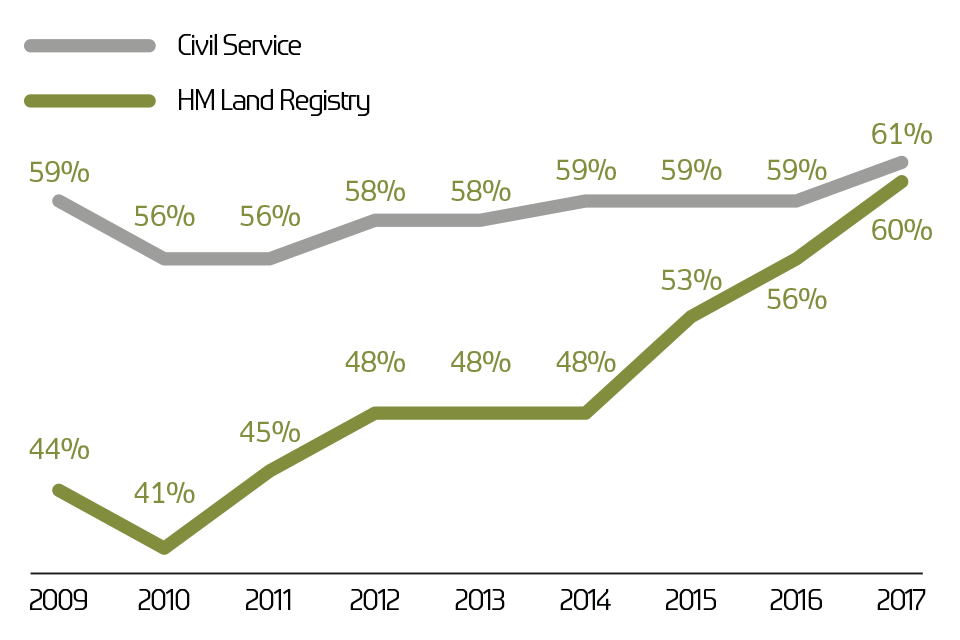
There has also been a positive upward trend around leadership and managing change where the biggest shifts have been in whether colleagues felt the Board has a clear vision for our future (up 18%) and whether senior managers demonstrate our values (up 13%). There is still a lot to do in this area. Our overall leadership score showed an 8% increase on last year and another record for HM Land Registry but not yet at our ambitious targets for the future set out in our Business Strategy.
We also listen to what our colleagues say in their response to blogs and on sites like Glassdoor. The feedback is sometimes mixed but we need to know what our people feel.

What have you been focusing on this year to prepare you for the future?
Ensuring our organisation is capable of delivering our ambitious transformation programme, safeguarding core service delivery and providing the building blocks for a more sustainable future.
A complete review of the senior management team resulting in 24 new, vacant and replacement posts was delivered in parallel to recruitment right through the organisation. This has included over 500 entry level roles of which over 150 were apprentices as part of a process to rebalance the workforce and build sustainability.
Creating entry level routes has had a profound effect on the organisation. Of the total headcount, 14% are now aged under 30 compared with less than 1% in 2014, reenergising pride as long-serving experts revel in the opportunity to pass on their knowledge and skills to a new generation.
We now run eight apprenticeship schemes with a 92% completion and 76% retention rate. Our apprentices make up 6% of the workforce.
Our efforts have not gone unnoticed and we were delighted and honoured to win the Sustainable Transformation category at the PPMA Excellence in People Management Awards 2018.
How are you ensuring that both new and existing colleagues will be ready for a more digital future?
Skills and confidence are equally important to our future success. To get the best out of our people we need inspiring leadership and effective managers. This year we have created a new leadership and development framework which focuses on building and maintaining core skills alongside new capabilities, such as digital, artificial intelligence (AI) and robotics to reflect the changing priorities, services and shape of our organisation.
Our apprentices have quickly integrated with their teams and have helped existing colleagues with the use of technology, challenged existing work processes and embedded new ones, resulting in a positive impact on performance. Several apprentices have joined a reverse mentoring scheme to help improve the IT literacy and confidence of senior managers, including one who reversed mentored our Chief Executive.
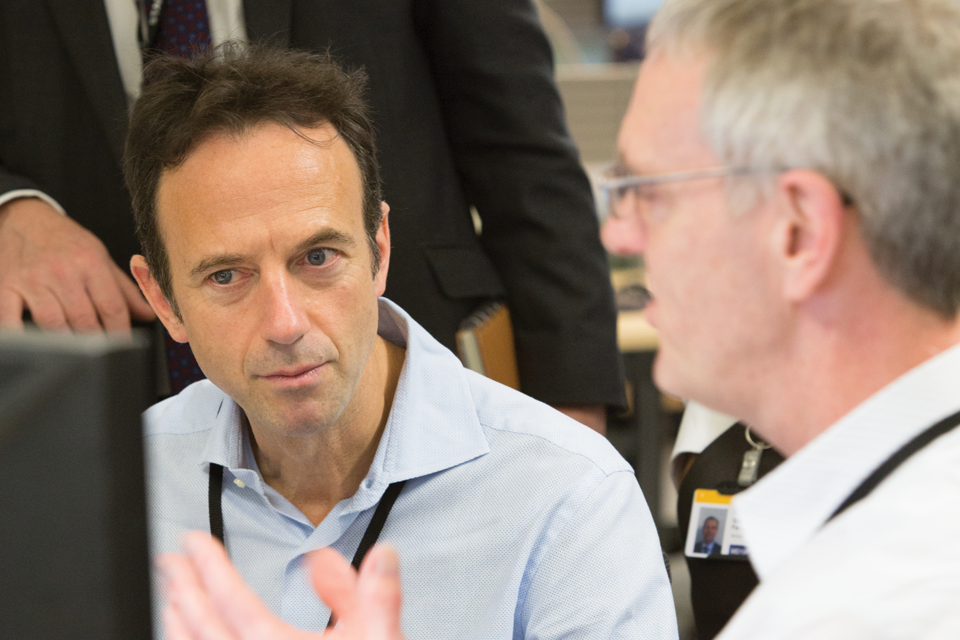
Alex Chisholm, the Permanent Secretary at the Department for Business, Energy and industrial Strategy, meeting our caseworkers in the Croydon office in January 2018
How do you see the organisation changing as you transform?
Delivering our Business Strategy will require fundamentally changing the organisation. Our current structures are not aligned to the developing programmes of work so we will need to change in order to maximise the benefits of our transformation programme for colleagues and for our customers.
We also need to continue to modernise our working environment supported by smart working principles and underpinned by enabling technology. Modernisation will ensure that our colleagues have rewarding and meaningful roles, including new opportunities for advancement.
Culturally we are developing a new management style which focuses on people and skills as opposed to process and systems. Supported by coaching, effective change management and an ethos-focused continuous improvement, it will be underpinned by holistic and integrated HR policies, including a new performance framework.
Our organisational design will inform future decisions about how we deliver our People Strategy, including talent management, succession planning, recruitment, career development and reward.
It is tempting to look at our transformation as simply the introduction of new digital systems and services but when you look at the scale of what we are trying to achieve, the changes we are making will have just as much impact, if not more so, for our colleagues as on our customers and the economy.
What is HM Land Registry doing to champion diversity and inclusion?
We continue to recognise and celebrate diversity and to create an inclusive environment where differences of thought and outlook are not only respected but encouraged. To support this, we have developed a Diversity and Inclusion Action Plan (2018-22).
We have Executive Board sponsors for all protected characteristics, and additionally for health and wellbeing and for charity, in recognition of the strong links between diversity and inclusion, health and wellbeing and the valuable charitable work undertaken in the community through our charity committees.
Our plans prioritise the key issues. Our focus is to build an inclusive culture and reputation that attracts, develops and fully engages diverse talent, and increasing representation from currently under-represented groups, particularly ethnic minority and disabled people, and women in management roles.
Getting more women into management roles will become our Diversity and Inclusion key performance indicator for next year and our broader and more inclusive approach has resulted in the creation of two more diversity networks, for ‘age’, and for ‘faith and belief’. We have clearly defined roles, responsibilities and accountability for diversity and inclusion throughout the organisation, and achievement of objectives will be better assessed through a wide range of measures.
A key part of our plan is to ensure we are talking about diversity and inclusion issues openly and freely. Working with colleagues drawn from across the organisation, including our diversity networks, our Internal Communication Team led the introduction of a new regular diversity and inclusion blog, allowing people to talk frankly about their experiences.
Colleagues have bravely shared personal experiences ranging from racism in the 1970s, through to child loss and coming to terms with their own sexuality. The response has been overwhelming, stimulating open discussions with colleagues showing their support and sharing their own experiences openly.
As a direct result of the positive impact, people have gone on to share their stories more widely via our external blog, such as ‘Tea and tablets for two’ which supported national activity around Mental Health Awareness Week.
You mentioned Mental Health Awareness Week. What else are you doing to support colleagues with mental health issues and wellbeing more broadly?
Health and wellbeing groups at local offices have played a big part in supporting colleagues. As well as running awareness campaigns on a wide variety of issues, local groups have devised many more active ways of contributing to the wellbeing of our people; from regular stretching and desk yoga sessions to organised weekly lunchtime walks. These help make sure that colleagues get up, move around and take a break from on-screen work.
Over the last year we have been reviewing and developing a different approach to mental health with our trade unions. Our colleague survey during Mental Health Awareness Week generated more than 5,300 comments and we were pleased that the results showed that most respondents felt able to talk to line managers about their mental health, and that there is good understanding of the support available in the workplace, including our Employee Assistance Programme.
Our Mental Health Action Plan, which has been agreed with our trade unions, aligns with our Attendance, Health and Wellbeing Framework, the Civil Service Strategic Priorities for Health and Wellbeing and Thriving at Work and the Stevenson/Farmer review of mental health and employers.
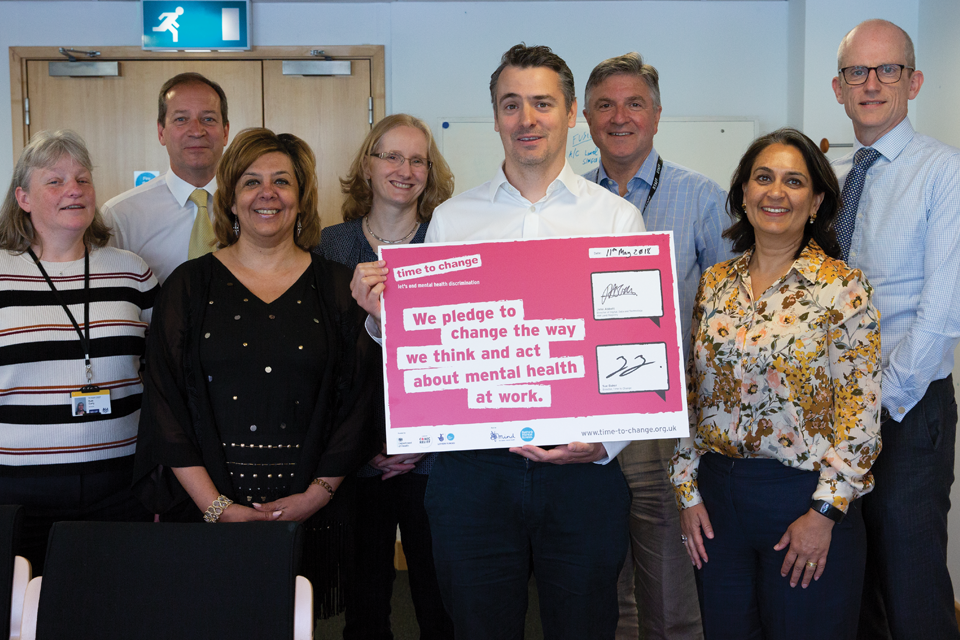
Health and Wellbeing Champion, John Abbott, together with fellow members of the Executive Board, re-signed the Time to Change pledge this year, committing the organisation to a series of actions that will help reduce the stigma of mental health
Creating a digital voice
‘Join the conversation’ is a buzzphrase in the world of social media. We have made it a reality in a corporate setting by giving everyone in HM Land Registry the opportunity to question senior managers directly, challenge decisions and open up new topics of conversation. The result has been rising scores for colleague engagement and for leadership and managing change.
Our new intranet, launched in April 2017, provides a transparent and public platform for two-way dialogue. We wanted to help colleagues foster a greater understanding of Board decisions, recognise the achievements of others and make the relationship with senior leaders more personal and accountable. Comments are made on all communications from blogs to news stories to guidance on casework practice.
Our Chief Executive writes a weekly blog alongside a second weekly blog by executive directors on rotation. They announce new initiatives and address current issues but also write about themselves and their lives outside of the organisation.
As soon as a blog is published the comments start to flow in and are rapidly assessed and published under the commenter’s name by the Internal Communication Team. Provided they do not contradict our values, all comments are published, no matter how critical. The conversations flow as comments are made on earlier comments and the blog author replies to the points raised. More than 8,000 individual comments have been moderated and published in 12 months.
Comment feedback has led to changes to key policies such as performance management and career progression. Where an issue raised requires further discussion, Directors follow up with face-to-face engagement during office visits.
To monitor impact on colleague engagement we conducted organisation-wide Pulse Surveys in between the annual Civil Service People surveys with response rates consistently above 60%. Results continue to show steady progress with the new communications channels and content cited as the main area of improvement in all qualitative feedback.
Our success was recognised by being shortlisted for the Internal Communications Campaign of the Year category in the UK Public Sector Communications Awards 2017.

Holy Island. Photo: Michael Conrad/Shutterstock
Holy Island, Northumberland: The Holy Island of Lindisfarne is a tidal island with access by a paved causeway, which is covered by the North Sea twice a day, and receives over 650,000 visitors from all over the world every year. The island was a unique and challenging registration for our Swansea Office as many parts of it are in separate ownership including the causeway, and Lindisfarne Monastery, which is separately registered to the Historic Buildings and Monuments Commission for England.
Our team of leading property lawyers reshaping the law
Mike Harlow, General Counsel and Deputy Chief Land Registrar

Mike Harlow, General Counsel and Deputy Chief Land Registrar
I joined HM Land Registry this year from Historic England. Before that I had 15 years in private practice acting in the commercial property market – a background similar to many in the directorate. I have always known HM Land Registry to be a reliable, expert and impartial institution. Since starting in my role, I have come to see that one of its most important assets – the best team of property lawyers in the country – are integral to that reliability and integrity.
The Legal and Assurance Directorate works in tandem with Operations to deliver our core value to society – accurate and trusted records of who owns what and who has a loan secured against the property.
Every year our lawyers advise on more than 45,000 cases. They manage more than 8,000 disputes themselves and pass around 1,000 cases with substantive issues to an independent tribunal for a decision.
Our risk and assurance teams check the quality of the ownership records and continuously provide recommendations as to how we can minimise errors and fraud and how we can drive improved quality generally.
We maintain the legal framework for registration and ensure it develops to meet the changing needs of the property market and the Government’s policy objectives. We support our transformation projects to ensure they deliver productivity alongside continued trust and confidence in our records.
We handle claims for compensation for mistakes or fraud, ensuring we learn the lessons from those cases, feeding information back into revised quality casework processes, or practice notes that are widely used by our partners in the conveyancing industry.
We do all of this by having an extraordinary breadth and depth of expertise across England and Wales’ complex, ancient and sometimes peculiar land law.
Our colleagues understand and are committed to the public value that HM Land Registry delivers. They are excited by its potential to contribute more to the property market and thereby to our economic, social and environmental progress.

Lombard Wharf. Photo: Barratt London
Lombard Wharf, Battersea, London: Barratt’s Lombard Wharf development won silver for Best Exterior Design at the WhatHouse?Awards 2017. The Thames-side residential building includes a penthouse which encompasses the entire 26th floor and features 360 degree views of London. Several of our offices are involved in registering the leases.
Reshaping the law
We have already begun reshaping the law to lead the market to new, secure opportunities that make the most of leading-edge technology. Two legal foundation stones of this new era were the focus of our work this year. The first was the Land Registration Amendment Rules 2018 that came into force in April 2018. They enable property transactions to happen using digital documents that are digitally signed. This provides the legal basis for the new digital mortgage service that is now being delivered. In the future they will allow a wider range of digital dealings with land, leading to further automation, making land registration faster and simpler.
The new rules enable the transformation of property dealings. They do not dictate how they will occur. Our role now is to ensure we deliver digital services that are as safe and efficient as the property market needs and deserves.
The second foundation stone was the legal framework for the delivery of local land charges information through our centralised digital instant-access service. The Infrastructure Act 2015 enabled us to engage in this activity and our project lawyers have since been devising the detailed machinery to deliver the service in practice.
This was no simple feat. Each local authority holds a wide variety of local land charges information in differing formats. The local land charges regime is the means by which various regulatory regimes are given effect, such as planning and the protection of our heritage. It is a fundamental part of the due diligence in property transactions. The fruit of this labour will be realised later in 2018 when the first local land charges information becomes available through our centralised and standardised online service.
Our focus for the coming year is on enabling the organisation to achieve its ambitious Business Strategy in way that protects the trust and confidence in property ownership.
To help us become brilliant at the basics we will deliver a new simplified fee order – the authority from government that sets out our cost-recovery charges. We will be consulting on how best the fee structure can be made fairer and make processing applications more straightforward and therefore faster.
We will be participating in cross-disciplinary development of the means of delivering a comprehensive register, digital transactions and secure data releases.
One critical underpinning exercise will be to plan how we will pass the necessary property and land administration law expertise to the next generation. We take our responsibility to maintain expertise in all areas of property rights, however esoteric, very seriously.
Defending people’s ownership
Delivering transformation of the organisation and innovation in the property market, while maintaining the vital trust and confidence in our register integrity, is not a straightforward task.
Fraudsters and attempted frauds are an ever-present threat. As the way in which we deal with property changes, the means by which frauds may be attempted also change.
Our duty is to safeguard property ownership. We do this through effective fraud deterrents that are constantly under review. Innovative methods of dealing with land and new technologies present both an opportunity and a challenge.
For the new digital mortgages complex layers of assurance and security sit behind the ‘Sign your mortgage deed’ service. The borrower’s identity is confirmed through the GOV.UK Verify service and our safeguards ensure the names on the deed match those in the register. Secure deed matching ensures that the borrower is presented with the correct mortgage deed for their transaction.
The borrower’s Verify account means they do not need to create a separate account with us and they can use the same details to access other government services. Conveyancers will still have a role to play in identity verification as they will continue to undertake the identity checks that they currently do as part of their due diligence.
Maintaining confidence
Our state-backed guarantee of title underpins confidence in the conveyancing system. It enables financial institutions to provide secure personal and commercial lending against property. It also provides protection for victims of fraud or unforeseen errors in the register. An indicator of the quality and security of our registers is the compensation we pay for mistakes and frauds. In 2017/18, we paid £5,445,825 for 852 claims, compared with £6,957,904 for 995 claims in 2016/17.
This is, though, a lagging indicator. Some of the claims will relate to mistakes or frauds that were entered in the register several years in the past. While consistent levels of payments are reassuring, it is the risks of mistake and fraud now and in the future, given the changing operating environment and our current and planned processes for managing risk, that provides the focus for our energies.
Paralegal apprenticeship scheme
Two pilot paralegal apprenticeship schemes are offering caseworker colleagues the opportunity to obtain legal qualifications.
The programmes take two to three years to complete and will result in professional membership of the Chartered Institute of Legal Executives (CILEx) and nationally recognised CILEx qualifications.
Anyone who obtains the CILEx qualification via the Senior Paralegal Apprenticeship will be able to apply for lawyer positions in the future. Developing these professional legal apprenticeships is part of our new People Strategy and is intended to provide a clear career path for everyone from new recruits to highly experienced colleagues right up to lawyer level.
Rob Bradbury of our Nottingham Office joined the paralegal scheme after more than 30 years with HM Land Registry because he wanted to continue learning and developing. “What I have liked most is learning more about why we do things the way we do and the theory behind it,” he said.
Fighting fraud together
Combating property fraud is a major challenge for everyone involved in the home-buying process. No single organisation can prevent fraud and we work with a range of partners to identify threats, develop strategies and implement counter-measures.
A key part of our deterrent strategy is our Property Alert service.
A successful media campaign, that included working with the BBC’s The One Show and collaborating with police forces to add content about property fraud to their website, helped us to exceed our targeted growth in subscribers by 58%.
Our campaign won the Government Counter Fraud Award for excellence in raising fraud awareness. An additional 70,000 properties are now better protected against fraud.
Digital transformation underway
John Abbott, Director of Digital, Data and Technology

John Abbott, Director of Digital, Data and Technology
It has been a remarkable year for HM Land Registry and it is clear our digital transformation is well underway.
Our digital aspirations span the entire organisation and are key to the delivery of our Business Strategy. From launching new discovery projects and recruiting expert colleagues to registering the first digital mortgage and exploring the possibilities of machine learning and robotic process automation (RPA), we have started to deliver on our vision of a fully digital land registration service.
Our programmes
Our groundbreaking research and development project ‘Digital Street’ is exploring the art of the possible and the future of property transactions with technologies such as blockchain (a secure distributed ledger) and AI. This is already informing our Digital Programme. The programme will transform the services we offer our users, making the process of querying or updating the register significantly simpler, faster and cheaper for all.
Working closely with the Government Digital Service (GDS), we are devising projects and designing the technology that will help us become the world’s leading land registry for speed, simplicity and an open approach to data. We are working in an agile way to ensure the services we launch are based around the needs of our users while also strengthening the integrity of the register and preventing fraud.
We are already starting to shape the future of property transactions and our position as a digital leader has grown among our stakeholders and customers. Our projects have benefited from broad and enthusiastic support across the industry and among wider stakeholders.
Finally, our Data Programme is focused on making HM Land Registry data more accessible to all in order to increase both the transparency and efficiency of the property market. As well as making more data available over the last year we are also enabling innovation in the market by supporting PropTech start-ups through our Geovation programme, in partnership with Ordnance Survey.
A more digital land registry
All of this work requires teams of expert colleagues to develop the ideas, carry out the user research and produce the software. We have significantly increased our capability and capacity, recruiting new digital expertise and enhancing our existing skills so we have the in-house capacity to achieve our objectives, supplemented where we need to.
At the heart of our digital aspirations is the creation of a digital register that will support the new services we are developing. At present much of the data in the register is unstructured and not machine-readable. Our aim is to transform this existing data into a digital register that supports our plans to create high quality, user-driven digital services that enable transactions to be completed automatically.
The way we are developing our services is gaining attention from digital colleagues across the sector and this is an exciting time for us and the conveyancing industry as a whole.
Digitally enabling our land registration experts
People naturally tend to focus on the new things and our Digital Street project has received a lot of interest and attention. Just as important is the work our colleagues have done behind the scenes to provide modern systems that meet the needs of our land registration experts.
Last year we delivered more than 9,500 changes to our underpinning IT infrastructure systems. Working closely with our operations colleagues we improved their existing systems and services. By removing pain points and making processes more efficient through automation or redesign while ensuring changes did not interrupt operational delivery we continued to support backlog reduction.
‘Workflow’ is a new digital system that helps us quickly move straightforward register update applications to the right experts in any location. By integrating it with existing casework systems we are maximising the number and type of applications we can manage through it. Workflow now helps approximately 1,200 colleagues handle more than 5,000 applications each day. Only a few years ago vans used to deliver applications across England and Wales to offices to then sort and distribute – now our experts simply click a button and the next case appears before them instantly.
We are exploring how RPA could help us automate routine processes. Much of casework involves validating applications sent to us as PDF documents. We want our experts to use their skills and experience to make judgements rather than administering validation steps. Working closely with Cabinet Office we have completed an RPA trial which showed how we can automate validation. We expect to put RPA into production later in the year, making it easier for customers to submit correct applications and using RPA to automate data entry and validation checks.
New services for our customers
Our customers are seeing our digital transformation become a reality and new services are launching soon with many others in the development pipeline. We are taking an agile approach to delivery, following industry best practice and the GDS Service Manual to guide our delivery. We work closely with users to research and understand their needs in order to ensure we build the right service. This means starting small and advancing through the phases of exploration, prototyping and development and testing known as the ‘discovery’ ‘alpha’ and ‘beta’ phases.
‘Sign your mortgage deed’
Our new service digitises the mortgage deed signing process and avoids the need for borrowers to find a witness, apply pen to paper and send their signed deed by post.
Instead they can view the deed created by the conveyancer by logging on at a time that suits them and confirm their identity using the GOV.UK Verify service. A code is sent by text to their mobile phone which they use to confirm they are signing the deed in a single click.
That is exactly what a homeowner in Rotherhithe, south-east London, did when they took out a loan from Coventry Building Society earlier this year.
The speed and simplicity of the process disguised a historic moment as their mortgage deed was the first to be digitally signed in England and Wales before being entered into the Land Register. Thanks to changes in the law, delivered by our legal teams, it also represented a vital first step in plans to deliver more digital services.
“We’re delighted to have worked with HM Land Registry and Enact Conveyancing on this industry leading initiative to speed up property transactions. Initial feedback has been very positive, with customers finding the process simple, quick and secure.” – Peter Frost, Coventry Building Society’s Chief Operating Officer.
‘Find property information’
This new service makes the information needed by homebuyers more accessible and easier to understand. It allows anyone to download a summary of information about a property, including the address, title number, the owner’s name and address, the price paid for the property, whether it is freehold or leasehold, whether there is a mortgage on the property and the lender’s contact details. During the year we have continued to iterate and improve the service based on user feedback. In particular we have significantly improved the address searching feature and added the ability to download an electronic copy of the property’s title summary and preview search results without signing in.
‘I want to protect my property’
We are investigating the potential of a new service that helps members of the public protect their property, or interest in a property, by keeping their contact details up to date. The service will raise awareness of what HM Land Registry does and the potential implications of us being unable to contact them. This will ultimately help to empower our customers and improve their protection against property fraud.
Developer services
Building on the work we did this year setting up expert Developer teams, we have been looking into the specific needs of property developers when they undertake larger schemes. We will continue to develop specific products aimed at making the registration of large developments simpler.
Digital Street – creating positive digital disruption
Interview with John Abbott, Director of Digital, Data and Technology
Tell us about Digital Street, what is it and what are you trying to achieve?
Digital Street is creating a vision of the future – this year we launched our ongoing research and development project exploring how technology can improve and ultimately transform land registration. It allows us to explore and visualise different ideas of how land registration might work in the future and make conveyancing simpler, faster and cheaper.
We want to find out how access to the right data at the right time can help people confidently make decisions about property transactions earlier in order to make buying, renting, selling, financing, building and managing property easier.
We are working with people across the industry, members of the public, data providers, government departments and technology start-ups, and testing cutting-edge technologies such as blockchain, AI and chatbots to see what they could contribute.
These technologies will underpin land registration in the future as well as conveyancing and mortgage lending. We all need to understand the impact they will have and take advantage of it. Digital Street is our way of thinking out loud.
What we are hoping to demonstrate is that services like these, using the type of technologies we are exploring, are the kind of thing we should all be considering. We should be ambitious. We should be bold. Technological change will only continue to accelerate. Research like this helps HM Land Registry to become an organisation that can respond to that change and make best use of it.
So what did you look at in this first year?
We started with users so organised a series of workshops and research sessions with people who are involved in land registration and conveyancing. We talked to conveyancers, estate agents, mortgage lenders, PropTech start-ups, homebuyers and sellers. Among other things, we asked them: “How do you see technology changing your role, or your organisation, over the next 10 years?”
Having understood better the problems and challenges with the existing process, and how access to data might help. We then built a fully digital register for a small group of freehold, leasehold and commercial properties in south-west England. The properties’ title registers, title plans and associated documents were all digitised and linked to other datasets such as coal and flood risk data. We built a 3D interactive demonstration system to show how it could work.
Using data from the digitised properties we held a hackathon to demonstrate the kind of services a digital register could enable by creating three prototype services.
What is a “hackathon”?
It’s where computer software developers and others collaborate intensively over a short time period, two days in this case, to create useable software. It was an ideal way to show how a fully digital register could transform the conveyancing and registration process.
Our experts worked with representatives from partners such as the Coal Authority, Conveyancing Association, Settled and Ordnance Survey to come up with quick solutions, building on the user research we had already done.
We wanted to explore how we can make the processes around buying a home easier by improving access to information, making it faster and easier to get a mortgage and automating much of the contractual process.
At the end we had three working prototypes to show what the future of conveyancing could look like and how this could be enabled by a fully digital register with data that was more accessible and available earlier in the process of purchasing a property. Digital Street is making the future happen today.
What have you got in store for Digital Street next year?
It was incredibly valuable working alongside the industry last year to develop the working prototypes. We gathered great insights during our first year which gave us direction for new areas that we should be exploring in year two.
Our plans for next year are just as ambitious. We want to complete the first fully digital transfer of a property – a digitally signed transfer that automatically updates the register is a global game changer. HM Land Registry will be a world leader in digitising the property market.
Showing that we can successfully and automatically update the register will be a significant proof-point for the Digital Programme and will inform some of the key architectural decisions we’re making over the next year – particularly those around the digital register.
To enable this we will continue Digital Street’s research into smart contracts, digital signatures and blockchain technology.
We will continue to engage with and work alongside key partners from the industry in year two of the project as we know we cannot solve all these problems on our own and want to make sure that the UK is the best place to locate a digital land business.
Prototype 1: Property Assistant
We found that buyers currently find out about issues with a property after they have made an offer, it has been accepted and they had instructed conveyancers.
We demonstrated how buyers could make firmer commitments when choosing a property by making more data available earlier. By asking chat-bot questions in plain English machine-learning could interpret the data about the property, giving them quick answers based on information about restrictions on the property, local land charges, ground hazards, street crime rates and local schools.
Prototype 2: Instant Mortgage
Securing approval for a mortgage can be a long and drawn out process. Connecting up the right information from the right sources earlier on can speed up the process for citizens and lenders.
We worked with lenders to demonstrate how an app could check the Land Register and other personal and property data sources to offer the citizen a list of pre-approved mortgage deals from a variety of lenders.
Prototype 3: Property exchanged on an HM Land Registry blockchain
We looked at the transaction process – from drafting and exchanging contracts to transferring funds, often a stressful process for buyers, sellers and conveyancers.
We demonstrated how buyers and sellers could navigate this process using a smartphone app through which the buyer and seller would configure and then sign the contracts digitally. Each step uses smart contracts, is entirely automated and is recorded on a blockchain, in a simple, fast and more secure way.
One map for the nation
Andrew Trigg, Chief Geospatial and Data Officer

Andrew Trigg, Chief Geospatial and Data Officer
Our ambition is to be the world’s leading land registry for speed, simplicity and an open approach to data.
It is not just about releasing data but we are also looking at data quality, cross-government collaboration and supporting PropTech start-ups. An open approach to data means a culture shift in how we perceive, treat and share our data for the benefit of the whole nation. Data is the essential fuel required by data scientists who use machine learning and AI to gain new insights and improve productivity. It improves transparency and enables both incumbent and start-up businesses to innovate.
Geospatial Commission
This year saw the creation of the Geospatial Commission, a clear signal of the importance of government data in the future of our economy. The commission has been set up to maximise the value of government data linked to location. HM Land Registry is one of six partner organisations which include Ordnance Survey, the British Geological Survey, the Valuation Office Agency, the UK Hydrographic Office and the Coal Authority. These will enable the commission to:
-
improve the access to, links between, and quality of the nation’s localised intelligence data;
-
look at making more geospatial data available for free and without restriction;
-
set regulation and policy in relation to geospatial data created by the public sector; and
-
provide strategic oversight and direction across Whitehall and public bodies.
This is a big opportunity for the UK economy. HM Land Registry is pleased that its pivotal role in UK geospatial intelligence has been recognised by making HM Land Registry one of only six partner bodies involved in the Geospatial Commission. HM Land Registry has been central to the creation and development of the Geospatial Commission and its priorities.
Releasing valuable datasets
We understand the potential value our information has to the economy. Property information can be combined with other types of data for all kinds of useful information and new services.
Our dedicated data teams are already responsible for managing the quality and release of one of the largest and most valuable geospatial datasets in the world. Our data experts are finalising our data release roadmap which will detail how we will be releasing as much information as we can from our register by 2020, building on the open data we already provide.
This year the value of our data to business and government was underlined again when we published our Commercial and Corporate Ownership and Overseas Companies Ownership datasets to support the Government’s drive to improve land and property transparency, and crack down on money laundering and corruption. By making the data available free of charge we removed a financial barrier that hindered its wider use by citizens, entrepreneurs and small to medium-sized enterprises. We had 24 customers in the year leading up to launch, which increased to over 2,400 in the six months since launch.
Data users of all kinds, from private individuals to large corporations and government bodies, have since been poring over the files and coming up with fascinating insights. Local authorities and housing associations are using the data to verify their estates and support housing decision-making, and private-sector organisations benefit from monitoring their property holdings, enabling better long-term strategic planning.
Geovation Programme
Our data is also being applied in a very visible way by the winners of our Geovation Programme. In partnership with Ordnance Survey the programme supports PropTech innovators and entrepreneurs through funding, expert support and access to data. Geovation gives digital start-ups access to data, expertise and £20,000 worth of funding to take their ideas to the next level.
The first cohort to join the programme have secured further investment totalling more than £1 million.
First cohort
-
Orbital Witness who are delivering data- driven identification of legal risk in property transactions and providing a new perspective for due diligence in real estate through offering historic site analysis with archives of high- resolution satellite imagery;
-
GetRentr, who use AI to track all UK property licensing regulations and consultations in real time and provides an automated service to ensure property portfolios are always compliant; and
-
AskPorter, a multi-channel communications platform with an AI digital assistant that serves as a personal assistant for property managers and a property concierge for customers and tenants.
Second cohort
Our second round of start-ups we will be supporting are:
- Skyscape, who use AI to analyse rooftops and identify opportunities to maximise space utilisation and address urban challenges, enabling asset managers to efficiently identify opportunities for utilising rooftop space, where value of existing and future stock can be increased (http://skyscape.global/);
- ThirdFort, a security enhancement tool to help property solicitors more efficiently process property transactions (https://www.thirdfort.com/);
- Fruumi, a friendly and efficient shared accommodation platform that empowers landlords to let out their property at lower risk and cost (https://www.fruumi.com/); and
- Hipla, a free platform that helps buyers evidence their buying position, which in turn provides transparency to estate agents and sellers (https://www.hipla.co.uk/).
Orbital Witness
“Earth observation intelligence start-up company and Geovation winner Orbital Witness is paving the way towards automating legal due diligence processes in real estate, initially by enabling property lawyers and conveyancers to more efficiently review and report on rights and restrictions affecting land and property.
“Orbital Witness aggregates key property, legal and historic information, including data supplied by HM Land Registry, onto an intelligent map, with automated drafting tools, to help highlight legal risk and reduce the time required to gather and assess the information and present findings to a client.
“Orbital Witness’ unique approach involves using archives of high-resolution satellite imagery to provide a comprehensive property insight. A client looking to acquire or develop a site can better understand the site’s history, such as the past uses and development of the site from an environmental or planning perspective.
“Orbital Witness aims to provide reliable information at a cost-effective price, available at the touch of a button, that lawyers and conveyancers could use to help provide answers to clients and avoid unnecessary delays or transactional costs.”
Edmond Boulle, Orbital Witness Co-Founder
Orbital Witness were one of three start-ups that successfully completed our first Geovation Challenge held jointly with Ordnance Survey.
How our data revealed London’s secret tunnels
Our Commercial and Corporate Ownership and Overseas Corporate Ownership datasets contain the details for more than 3.4 million property titles owned by commercial and corporate organisations incorporated in the UK. In November we released this data for free, supporting the aims of improving land and property transparency and cracking down on money laundering and corruption.
Activist and writer Guy Shrubsole used it to uncover various tunnels and underground chambers beneath London owned by the Post Office, BT and the Ministry of Defence from both World War II and the Cold War era. Using our INSPIRE Index polygons data he was able to make a digital map of the tunnels on his blog which was reported in the Financial Times and the Daily Mail.
Building a strong foundation for change
Karina Singh, Director of Transformation

Karina Singh, Director of Transformation
Our planned transformation to become the world’s leading land registry for speed, simplicity and an open approach to data is complex. It requires constant oversight and direction to keep it aligned to our ambition and on track to deliver the outcomes and benefits. The Transformation Directorate was created in recognition of this need for an overarching oversight and central leadership.
Our focus has been to align our standards, ways of working and roles with the Cabinet Office Project Delivery profession standards, to give ourselves the assurance that we are designing, delivering and managing change in the best possible way. We are building a strong team, with a good balance between breadth of experience and deep knowledge of land registration.
We reviewed our existing projects and programmes and have brought together over 35 different change activities into seven programmes of change that clearly align with our Business Strategy outcomes.
-
The Digital Programme will create new services built around the needs of our customers and build modern, intuitive tools for our colleagues to process applications.
-
The Data Programme will improve the quality of our data and publish it for the benefit of the wider economy.
-
The Customer Programme will make our customer interactions simpler, faster, consistent and bespoke for those who need additional support.
-
The Local Land Charges Programme will lay the foundations for a national digital Local Land Charges service.
-
The Fee Order Project will simplify the structure of our fees.
-
The IT Infrastructure Programme will improve the resilience and flexibility of our underpinning IT to support our digital future.
-
The Estate Programme will define and implement the modern ways of working we want in our 14 locations.
-
The Service Improve Programme will streamline our internal processes so we can do our work with less effort and more consistently.
-
The Fusion Project will bring together our HR, finance and procurement systems.
This scale of change is a collective leadership challenge. The executive directors share the accountability as Senior Responsible Owners (SROs) for the programmes to maintain a collective oversight and stake in the delivery of change. To facilitate this, directors meet monthly as a Transformation Board with additional support from policy, technology and communications colleagues to oversee the collective changes.
Local Land Charges Register
A local land charge is an obligation on a piece of land or property and can be anything from a smoke control order to the historical listing of a building. Local land charges searches are therefore normally conducted when buying a property and are essential to mortgage lenders’ understanding of the risks to their loans.
A new digital register will hold all the information about local land charges. This information is currently held by 326 local authorities and searches can be inconsistent, priced differently, slower and less digitally accessible than they could be which slows down property transactions. The easy-to-use interface has been designed with customers in mind and we have worked closely with individual local authorities to ensure a smooth transition. IPSOS has also carried out a helpful survey of users. Starting with an initial group of four local authorities in summer 2018, which will expand to 26 by the end of next year, we are ready to begin migrating data into the new register. We estimate that during this phase up to 125,000 homebuyers will benefit from the new service.

Olympic Park. Photo: Taylor Wimpey.
Olympic Park legacy: The 2012 Olympics captured the nation’s imagination. Aside from the legacy aim of increasing participation in sport there was also the ambition of rejuvenating the site in Stratford, east London, which became the Queen Elizabeth Olympic Park. Our Leicester Office worked directly with the London Legacy Development Corporation and Taylor Wimpey. The scale of the development is immense with 26 separate housing projects being delivered on the site of the Olympic park. Early engagement with the developers allowed our experts to simplify the sales of individual plots by addressing issues prior to completion which enabled the registration of the plots to be completed more quickly and consistently.
Caring for and supporting our communities
We are committed to performing as a responsible business, contributing to wider community activities, and we provide encouragement and support to our people to enable them to achieve this aim.
Fundraising and volunteering
Supporting charitable causes that benefit local communities has always been part of the social fabric of HM Land Registry. A total of £88,832 has been collected for charities across the organisation as a whole over the year, nearly 25% more than the previous year. A ‘head shave’ at our Plymouth offices raised the most donations in a single event with £3,394 in aid of St Luke’s Hospice, Macmillan and the P&C Cancer Fund. Several of our offices celebrated milestone anniversaries this year, providing further opportunities to support local charities. Events were held at our Hull office (marking 30 years of land registration), Weymouth (40 years), Croydon and Swansea (50 years) and Fylde (60 years).
In addition to charitable fundraising, many colleagues take advantage of the ability to claim up to three days paid special leave for volunteering and more volunteer in their own time.
Director of Human Resources and Organisation Development Caroline Anderson said: “We actively support the work of our charity committees. Not just because of the clear benefits it provides to others, but because they provide connection and richness to our working lives, which helps reinforce our values.”
Protecting our environment
We are exceeding and well on course to meet all of the Greening Government Commitments (GGC) targets for 2020.
-
Paper consumption – 68% reduction*
-
Carbon – 49% reduction*
-
Waste generated – 47% reduction*
-
Water consumption – 28% reduction*
*against 2009/10 baseline
Energy saving – Best in the UK, outstanding in Europe
Our energy-saving initiatives were recognised at an international level. The Telford office was one of several in HM Land Registry to take part in the European Union-funded Save@Work competition aimed at cutting energy use and carbon emissions at public buildings through behaviour change.
Telford’s 18% energy saving secured it first place in the UK and fourth place in Europe against competitors from across the continent. The prize included 1,000 euros to spend on a sustainability initiative.
Their success was achieved by introducing simple changes including retrofitting car park lighting with LEDs, awarding cakes to teams for switching off their monitors, turning down the heating and constantly communicating simple ‘switch it off’ messages.
“We were delighted to represent the Save@Work team from Telford,” said Clare Francis of the Telford Office team. “Everyone in the office contributed to the energy savings we achieved – without the support of the colleagues we wouldn’t have achieved such a respectable fourth place. It proves we all can make a difference and we aim to continue to support and reward this.”
Performance analysis
Financial review
Ruth Curry, Acting Director of Finance and Business Services

Ruth Curry, Acting Director of Finance and Business Services
The past year has been the first of our transformation plan to deliver the 2017-2022 HM Land Registry Business Strategy. Demonstrating that we are financially strong is a key commitment in that milestone document which is evidenced by a year of solid performance against the backdrop of an unpredictable property market.
Through our Medium Term Financial Strategy we have ensured that our income will fund and therefore sustain our ambitious plans, enabling us to transform and modernise the services we provide and how we provide them, while at the same time continuing to deliver our core statutory duties.
This year we created a new centre of excellence to provide high quality management information. Our performance management group supports the organisation by providing detailed insight into our performance, including tracking delivery against our key performance indicators. We have continued to build our Finance Business Partnering function, ensuring finance is at the heart of decision making within HM Land Registry and that colleagues across the organisation have the financial and commercial skills they need to maximise the use of our resources and deliver value for money.
Getting the basics right within Finance requires good forecasting, accurate reporting, robust data and efficient transaction processing. We are committed to ensuring our colleagues have the tools they need to deliver. Finance is in the implementation phase of a new Enterprise Resource Planning tool which will replace our legacy Finance, Procurement and Human Resources systems. Not only will this new tool bring greater efficiency, but it will also support a modern work environment and culture which is a key component of our People Strategy.
Our investments have not just been focused on ourselves and delivering our internal transformation aims. This year we have also fostered greater innovation in the UK’s digital economy by supporting PropTech start-ups as part of our pioneering partnership with Ordnance Survey through Geovation.
Through effective use of our resources, our financial strategy and our robust systems we will continue to ensure that the wide range of plans set out in the Business Strategy to transform and modernise our services are sustainable and affordable. In doing so we remain on course to become “the world’s leading land registry for speed, simplicity and an open approach to data”.
Financial summary
| 2015/16 | 2016/17 | 2017/18 | Variance (15/16 to 17/18) | |
|---|---|---|---|---|
| £m | £m | £m | % | |
| Income | 295.4 | 311.4 | 317.2 | 7.4 |
| Total costs | (260.8) | (246.8) | (263.6) | 1.1 |
| (Of which were operating costs) | (254.2) | (241.9) | (257.4) | 1.3 |
| Surplus before dividend | 34.6 | 64.6 | 53.5 | 54.6 |
| Dividend | (13.6) | (18.9) | (28.7) | 111.0 |
| Retained surplus | 21.1 | 45.7 | 24.8 | 17.5 |
| Capital expenditure | 5.6 | 10.6 | 12.8 | 128.6 |
| Net assets | 373.6 | 422.2 | 446.4 | 19.5 |
| Return on capital employed (%) | 8.6 | 15.1 | 11.1 | 29.1 |
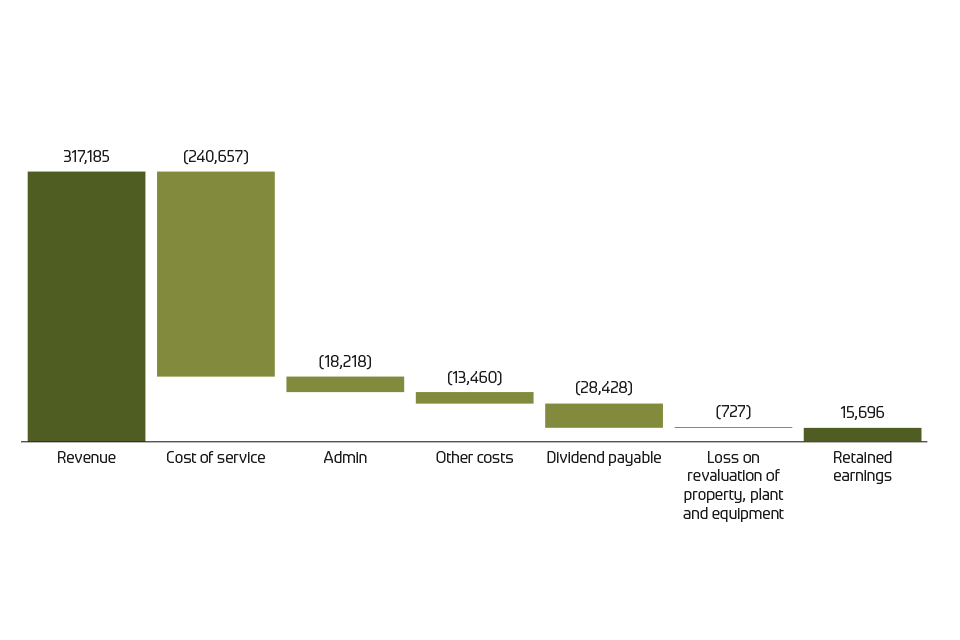
Revenue
The property market in England and Wales remains active, resulting in a year-on-year increase in overall revenue of 2% to £317.2m in 2017/18.
Alongside ongoing property transactions, a thriving remortgage market meant that, as in previous years, nearly half our revenue was driven by changes to existing register entries (register updates). This single service accounted for £150.3m in 2017/18 which alongside our other register change services meant that creation of new register entries or changes to existing ones accounted for nearly three-quarters of our revenue (register change services – £231.3m – 72.9%).
Our other major service revenue income came from guaranteed query services. These guaranteed searches and checks are critical steps in every property transaction and is where we see our largest volume of service demand. As these services are largely automated they do not carry as high a fee as our Register change services which require input from our expert professionals. In 2017/18 guaranteed query services accounted for 17.4% of our overall revenue.
Information services enable users to go online to get a snapshot of any registered plot of land or property. We charge for some information services, such as register views, as well as offering free online services, including MapSearch and Property Alert. Information services generated 6.0% of total revenue (£19.1m).
Together, these three core registration services generated £304.6m (96%) of £317.2m revenue in 2017/18 (see Note 2 of the Accounts for more details) with an operating cost of £253.9m (which was 98.6% of the total operating cost, £257.4m).
This is why our Business Strategy focuses our transformation on digitising guaranteed query services and the more straightforward register updates. By focusing our efforts on the largest volume of work that generates the most revenue we can both drive down our overall operating costs and make conveyancing simpler, faster and cheaper.
We also have responsibility for providing other land and property services. Land Charges and Agricultural Credits together generated £6.9m.
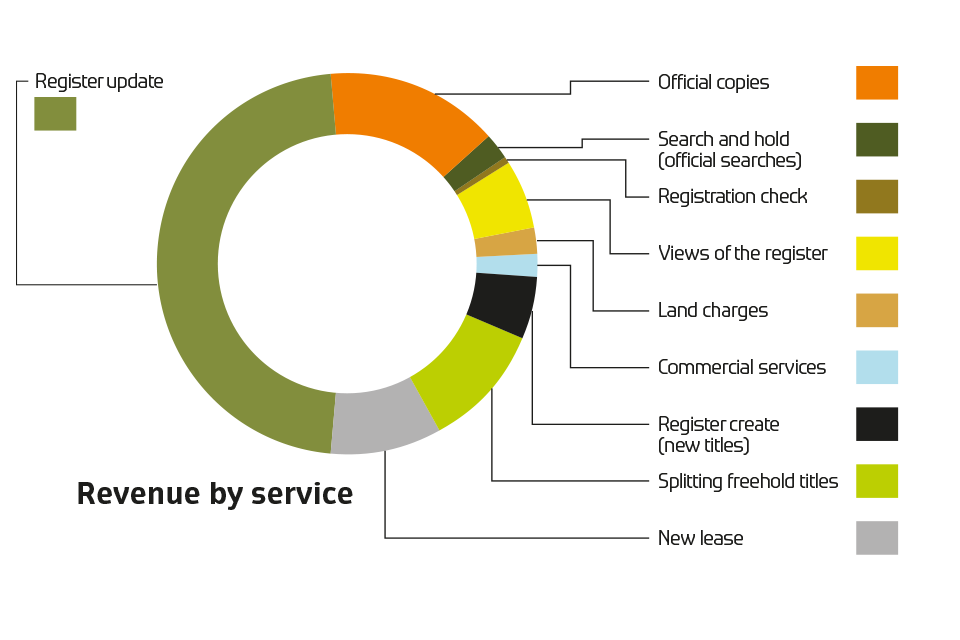
In addition, we offer free and commercial data services for customers such as technology innovators and data scientists. Income from the commercial release of our data generated £5.8m in 2017/18. Our ambition is to be the world’s leading land registry for speed, simplicity and an open approach to data and we intend to release all of our publishable and available data by 2021. Our income will be used to support the release of our further datasets with the aim for them to be open or free of charge whenever possible, subject to individual business cases being agreed for each release.
Our other services contribute a much smaller proportion of our overall revenue.
Operating costs
We operate in an active market where service demand continues to increase year on year but our responsibility to protect the register always remains. In order both to deliver and drive performance alongside our wider transformation aspirations, our operating costs increased by 6% to £257.4m in 2017/18 (2016/17: £241.9m). Having driven efficiency savings in 2016/17, reducing our operating costs by 5% compared with 2015/16, we have maintained a focus this year on securing value for money while at the same time responding to operational requirements.
We recruited more expert colleagues and funded increased overtime to reduce our backlog and improve our speed of service. This resulted in salary costs increasing by £11.0m from £179.5m in 2016/17 to £190.5m in 2017/18, reflecting our increased workload.
Other operating costs included an increase of £5.9m in our indemnity provision, compared with an increase in the provision of £0.3m in 2016/17. This £5.9m growth is made up of a £2.8m increase in the outstanding provision indemnity costs and a £3.1m increase in the incurred but not reported (IBNR) provision. The increase in IBNR provision was due primarily to changes in the HM Treasury long term discount rate.
Impairment and depreciation costs included within the operating cost increased from £4.1m in 2016/17 to £5.0m in 2017/18, a movement of £0.9m.
Looking at the year ahead we are already seeing encouraging results from our Model Office trials in Durham and Plymouth. As we roll out our continuous improvement programmes more widely, we expect to generate more internal process efficiencies through both standardisation and automation.
Capital structure
The amount of Public Dividend Capital remains unchanged at £61.5m. The Revaluation Reserve has decreased by £1.1m, £0.4m of which has been transferred to retained earnings.
A dividend payment of £28.7m will be made to HM Treasury which results in a retained surplus of £24.8m. In combination with the revaluation transferred to retained earnings, the Income and Expenditure Reserve has therefore increased by £25.2m to £366.7m.
The Local Land Charges Programme will be funded through our accumulated reserves, with fees subsequently generated from the service to be used to reimburse HM Land Registry reserves for the investment made in the programme. Local Land Charges will be implemented in phases, with Phase 1 expected to go live in 2018/19. The 15-month Phase 1 will digitise, standardise and centralise local land charges data and associated services from approximately 26 local authorities.
Indemnity Fund payments
In 2017/18 we paid £5.4m for 852 claims, compared with £6.9m for 995 claims in 2016/17. The largest claim paid this year was for a register entry error where a restrictive covenant entry had been omitted and an indemnity payment was paid for £0.9m (see note 17.2 in the accounts and Appendix E).
This year the value of the outstanding claims provision increased to £10.8m (2016/17: £8.0m). The impact of this increased provision was a charge of £2.8m to our operating costs (2016/17: £2.5m charge).
The value of the Indemnity Fund incurred but not reported (IBNR) provision has increased to £80.2m (2016/17: £77.1m). The impact of this increased provision was a charge of £3.1m to our operating costs (2016/17: £2.8m). Further information on outstanding claims and IBNR provisions, including sensitivity analyses that reflect the estimated nature of the IBNR liability and susceptibility of the provision to fluctuation, can be found in note 17.2 in the accounts. See Appendix E for more information.
Treasury management
Management of liquid assets is governed by the Land Registry Trading Fund Order 1993, the Additional Assets Order 1996, the Extension and Amendment Order 2003 and the Framework Document 2012. Non-operating cash balances are maintained in interest bearing accounts at the Government Banking Service and the National Loans Fund with the balance held with a UK commercial bank.
Estates and facilities management
We have continued to reduce the size of our estate, with all surplus estate now disposed of and tenants occupying 18% of our estate. Our total spend on property (including rent, business rates and service charges) and facilities management (including utilities, post and reprographics) was £17.3m.
We have two properties meeting the definition of investment property – the second floor of Weymouth Office and the Earle House extension in Hull – all of which are let on a commercial basis.
We are committed to demonstrating consistent improvements in the effectiveness and efficiency of our estate in support of the Government’s efficiency and reform agenda.
Our facilities management contract with Carillion Services Limited was due to expire at the end of 2017/18. Along with five partner organisations in BEIS, we jointly tendered our facilities management services’ requirement. This “clustered” contract was awarded to ISS in December 2017 and was due to go live in April 2018.
Throughout the year, along with Carillion senior management, we closely monitored the performance of Carillion Services Limited. As part of this we developed contingency plans to be used in the event of the supplier being unable to deliver some or all services to the standard required. Due to the liquidation of Carillion on 15 January 2018, the new Total Facilities Management Contract with ISS was mobilised on 5 March 2018, a month earlier than originally planned, following intensive negotiations between both parties. The transition from Carillion to ISS ran very smoothly, reflecting the level of hard work and commitment between HM Land Registry, ISS and Carillion to ensure there was very little impact to service delivery.
The amount payable for services delivered in 2017/18 was £8.5m to Carillion Services Limited and £0.5m to ISS.
Non-current assets
The value of our estate is now £52.7m, including assets held for sale of £2.1m.
Total capital spend, primarily on IT, software and capitalisation of Local Land Charges development costs, was £12.8m of which £4.1m related to tangible assets and £8.7m intangible assets.
Fee order
During 2018/19 we are planning to consult on updated fee structure proposals. The current fee order structure has been in place for more than 30 years and was designed to serve a paper-based registration system. HM Land Registry regularly reviews the level of fees set and, in the past, fees have been lowered as in the 2012 fee order. The current fee order, which came into force in 2014, reduced the number of scale fee bands and introduced a discount for lodging register updates electronically.
The intention of our new proposals would be to simplify our fees, reducing the number of different types of fee payable, and to better align the fees to the cost of delivering the services we offer. Any changes would not be designed to raise additional revenue but to remain neutral overall, with future changes expected to reduce fees as efficiency savings are realised from the Digital Programme.
As part of the consultation proposals’ development, a Regulatory Impact Assessment has been undertaken so that we can understand the effect any proposed changes would have on our customers. We have also been in discussion with a number of government stakeholders including BEIS, HM Treasury, the Ministry of Justice and the Ministry of Housing, Communities and Local Government to ensure our proposals would support wider Government aims.
HM Land Registry status
The Office for National Statistics (ONS) is currently undertaking a review of the sector classification of HM Land Registry in accordance with the provisions of the European System of Accounts 2010. HM Land Registry is currently classified as a Public (Non-Financial) Corporation. HM Land Registry has provided detailed information to the ONS to inform its decisions as to whether HM Land Registry’s existing status should stand or if HM Land Registry should be reclassified to the Central Government subsector.
Performance against targets
See ‘Our performance’.
Directorships and significant interests
Directorships and significant interests are covered in the corporate governance report.
Future expenditure trends

The graph above shows the cumulative surplus before dividend and Local Land Charges (LLC) costs, total dividend and cumulative net LLC costs in our central forecast scenario, as set out in our Medium Term Financial Strategy, between 31 March 2018 and 31 March 2023. Dividends are payable to HM Treasury at a rate of 3.5% of the average capital employed during the year plus inflation. The graph shows that between 2018 and 2023, we have forecasted an increase of net assets of £59.0m, which will be used to invest in our transformation.
Our Market Insight and Forecasting Team regularly reviews housing market trends. However, a potentially fluctuating property market makes it innately difficult to predict the volume and nature of HM Land Registry’s workload. Therefore, we continue to model a wide range of potential scenarios, reflecting possible changes in both revenue and cost. Given current economic conditions and the potential sensitivity of our forecasts, we have built in a degree of resilience to provide the flexibility we may need to deliver our transformation even if the market changes.
The investment in our digital transformation is reflected in both revenue and capital expenditure. Core business costs are expected to fall as the benefits of our digital investment are realised, though these are offset in the short term by one-off costs and the amortisation of the capital investment.
Corporate financial targets
| 2017/18 | 2016/17 | |||
|---|---|---|---|---|
| Actual % | Target % | Actual % | Target % | |
| Percentage return on average capital employed | 11.1 | 4.3 | 15.1 | 4.6 |
Auditors
The accounts have been audited by the Comptroller and Auditor General (C&AG). The cost in respect of services relating to the statutory audit for 2017/18 was £65,000 (2016/17: £65,000).
Our performance
In 2017/18 we agreed 11 key performance targets, split across four values
We give assurance
We guarantee our services and provide confidence to the property market.
Customer satisfaction
The percentage of customers who rate our overall service as good, very good or excellent will achieve at least 90%
-
Target: 90%
-
Performance: 92.49%

Quality
Substantive registrations to pass at least 98% of defined quality checks
-
Target: 98%
-
Performance: 98.41%

Comprehensive registration
To create a list of the unregistered public estate in conjunction with the Government Property Unit by end of March 2018
-
Target: Unregistered public estate list
-
Performance: Achieved
We drive innovation
We are forward thinking, embrace change and are continually improving our processes.
Online service availability
Average external e-services availability at 99.6% or higher during published service hours
-
Target: 99.6%
-
Performance: 99.92%
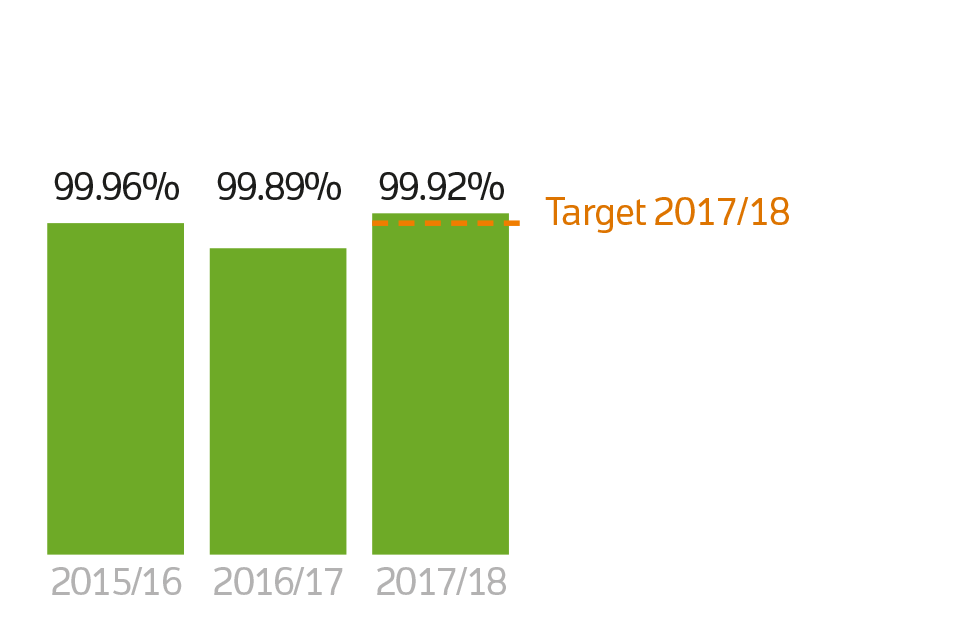
Research and development
We will build a Digital Street proof of concept by December 2017
-
Target: Launch Digital Street and build a proof of concept
-
Performance: Achieved
Modernisation
We will modernise the way we do business, driving continuous improvement across our operations
-
Target 1: Launch ‘Model Office’ continuous improvement initiative
-
Target 2: 5% saving on non-staff related third-party spend
-
Performance: Achieved
We have integrity
We value honesty, trust and doing the right thing in the right way.
Cost per register update
Average cost per dealing (register update) application not to exceed £27.34
-
Target: Average cost per register update not to exceed £27.34
-
Performance: Achieved

Speed of service
By March 2018 we will complete registration of all dealing applications within five days and all new title applications within 25 days respectively, excluding those applications where it is not possible, which will have been assessed and categorised within these timeframes
-
Target: Complete all register update applications within five days and all register create applications within 25 days
-
Performance
-
Register update: 98%
-
Register create: 45%
-
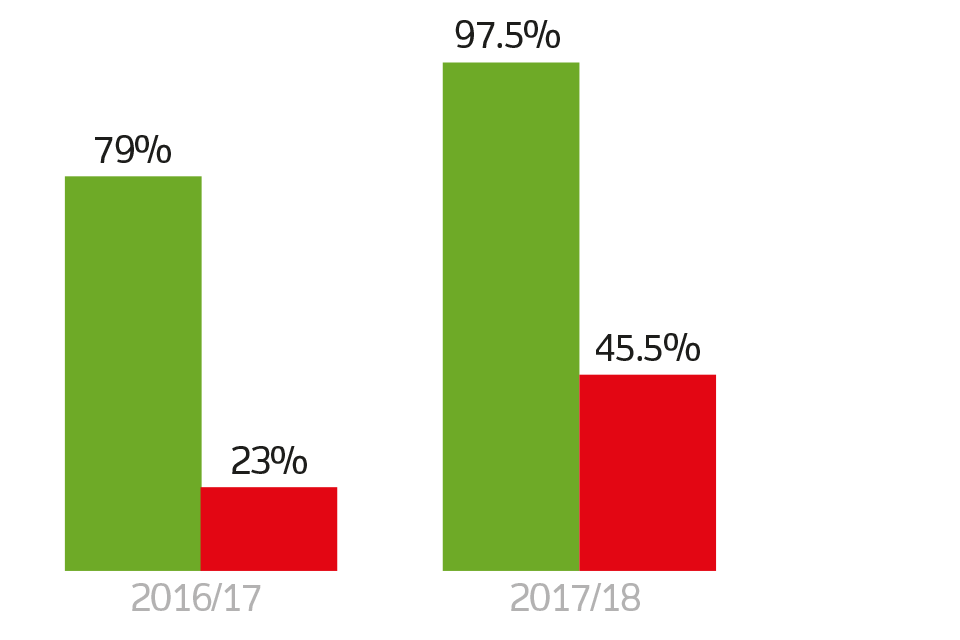
Reducing application enquiries
We will agree a strategy for reducing requisition rates and refunds for cancellations by March 2018
-
Target: Agree a strategy for reducing application enquiries
-
Performance: Achieved
We are professional
We value and grow our knowledge and professional expertise.
Colleague engagement
Staff engagement score to be in top half for the Civil Service for organisations of equivalent size and nature by the 2017 survey
-
Target: 58%
-
Performance: 60%
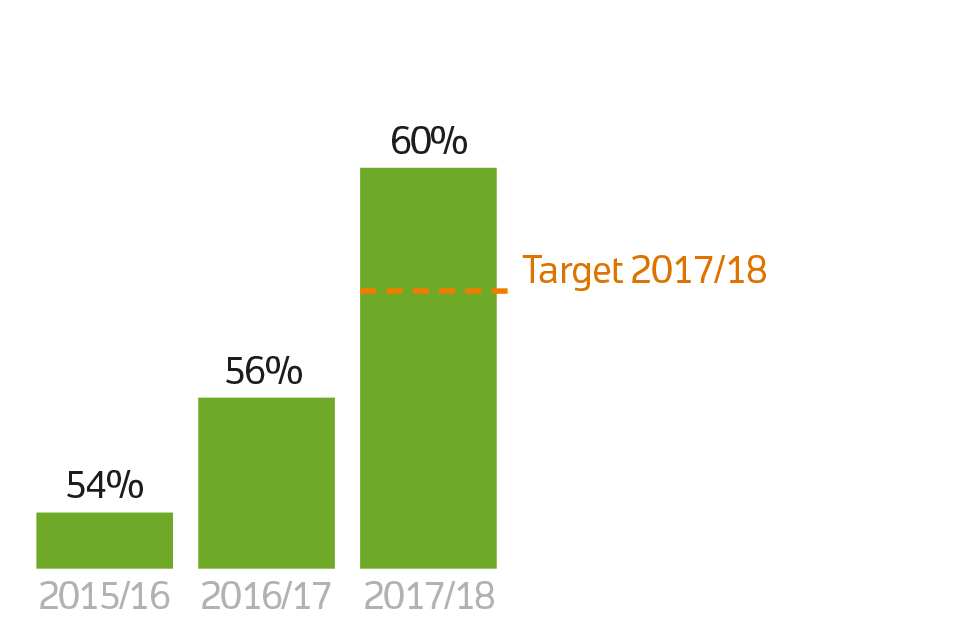
Leadership and managing change
Improvement in the engagement score for leadership and managing change of five percentage points compared with 2016 baseline
-
Target: 38%
-
Performance: 41%

Our performance in depth
In 2017/18 we agreed with ministers our 11 key performance targets, split across our four values.
-
We give assurance
-
We drive innovation
-
We have integrity
-
We are professional
Our targets are also reflected in our Business Strategy. The five indicators relating to customer satisfaction, quality, speed and online service availability are deemed to be ‘core’ key performance indicators as they relate to the delivery of core registration services while the remaining indicators are there to reflect our wider ambition to become the world’s leading land registry for speed, simplicity and an open approach to data.
We give assurance
As a trading fund service provider, funded entirely from fee income, it is of utmost importance to us to have customer satisfaction and meeting customer needs at the heart of what we do. To help us measure how well we are meeting these goals, we commission IPSOS Mori to undertake four quarterly surveys on our behalf, each of 300 representative customers, to independently measure satisfaction. The average of the four surveys is used to calculate the final result.
Our performance on our main customer key performance indicator (KPI) is higher than last year but there is further to go. We have developed, and in 2018/19 will be implementing, a new Customer Strategy which aims to provide greater quality and consistency of service and better meet customers’ individual needs. The Customer Satisfaction Surveys in 2017/18 show some early indications of improved customer perceptions of consistency and accuracy/quality. There is also evidence of improved perceptions of the value we place on our relationships with customers.
The integrity of the register is paramount. As the definitive record of property ownership and interests in England and Wales, ensuring the register is accurate and of the right quality is vitally important. Our Register Integrity and Assurance Group validates accuracy of our registration work in four key areas every month by auditing two samples, each comprising 1% of applications completed over five consecutive working days.
We will develop a new quality KPI for the 2019/20 financial year in line with our Business Strategy core service target – we will have new quality measures that improve the integrity of the register.
Our aim is to create a comprehensive register of freehold land, where the owner is known and the area/extent of their ownership can clearly be defined, by 2030. This will provide greater transparency regarding ownership of land and will aid better data sharing across government for supporting development, including in planning for the right homes in the right place, and to build homes faster. The first milestone was to create a list of the unregistered public estate in conjunction with the Government Property Unit by the end of March 2018.
Through considerable collaboration between the Government Property Unit and the Ministry of Housing, Communities and Local Government this KPI has been achieved. This will help with the process of engagement with local authorities to work towards achieving the next two milestones of registering all local authority housing stock by 2020, and registering all public land in areas of highest housing need (as identified by the Ministry of Housing, Communities and Local Government) by 2020.
We drive innovation
The availability of our e-services is of critical importance to our business. Most of the applications our customers submitted were lodged via our e-service channels. This target is calculated by measuring the availability against advertised service hours for five of our online channels. These are:
| System | Description | Published daily service hours | Annual hours | Maximum downtime hours |
|---|---|---|---|---|
| Business e-services | Portal for professional customers to access our full range of e-services | 16.5 | 6,023 | 24 |
| Business Gateway | A seamless interface into customers’ case management systems | 16.5 | 6,023 | 24 |
| Inspire | A service that provides access to HM Land Registry index map polygons | 24 | 8,760 | 35 |
| Find a property | A service aimed at citizens that provides access to copies of the register | 24 | 8,760 | 35 |
| Corporate website | HM Land Registry information hosted on GOV.UK | 24 | 8,760 | 35 |
| Total | 38,326 | 153 |
We will continue to migrate our external services to new information technology (IT) infrastructure, building on investment made in 2017/18, while continuing to enhance our cyber security defences. We are committing to an enhanced KPI of 99.7% for 2018/19.
The Digital Street proof of concept was identified as part of the digital transformation roadmap in our strategic review. It set out to demonstrate how technology could help transform land registration and conveyancing as we enter the next decade and also understand the capabilities and benefits of a fully digital register.
We achieved our KPI by:
-
carrying out user research and bringing together key stakeholders from across the industry for a series of ‘design thinking’ workshops which explored how we could revolutionise the property buying process;
-
creating a ‘digital street’ by building a fully digital register for a small number of properties;
-
running a successful two day hackathon and developing three proof of concepts using digitised HM Land Registry data and other property datasets; and
-
creating a three-dimensional interactive demonstration to show the digitised street.
Through research and development we will continue to explore how data and technology could revolutionise land registration and conveyancing. We will work with industry to explore ideas and potential solutions, and learnings from Digital Street will feed into our Digital Programme. For 2018/19 our progress will be monitored through our business plan rather than as a KPI.
Our continuous improvement initiative called Model Office was delivered in two phases – process control and process improvement. In 2017/18 we developed three tranches of trials which looked to standardise and improve ways of working across the Operations function. As part of this, Team Design and Dealings Flow ensured the same way of working across all non-developer teams in terms of how work is organised. This has resulted in productivity uplifts of 14%, alongside developing our colleagues skills through exposure to different types of casework. Local change managers have supported local leadership teams in establishing a continuous improvement ethos, with specific training also delivered to those leadership teams.
Model Office will continue as a concept in 2018/19 and will support the Service Improvement Programme. In particular it will be the test-bed for process improvement and casework system improvement activity.
Our customers are always at the heart of our decisions so we will minimise the fees we charge to cover the costs of our services and our improvement programme. By targeting cost reductions and productivity improvements, we can demonstrate efficiencies. We did not plan for our staff costs to fall this year as we invest in improvements to our processes and systems, so we have focused on reducing third-party expenditure, excluding the development of the Local Land Charges service, to demonstrate efficiencies. We achieved a cost reduction of 10.4%, against a target reduction of 5%.
We will continue to seek efficiencies in processing our core services and our continued investment in modern technology and digital processes will in turn generate future efficiencies and cost reductions.
We have integrity
This year we introduced a new efficiency measure focusing on our core registration service – register updates. This will enable us to demonstrate the efficiencies made through service improvements and our programme of digitisation. As this measure is based on the full cost of delivering the register update service, including upgrading and transforming this service, in the short term these efficiencies will be offset by increased investment costs. We achieved an average cost per register update of £25.54, against a target of £27.34.
We are committed to reducing the average cost per register update year-on-year in real terms. We will continue our investment in improving registration processes and expanding our digital service offering, the cost of which will be matched by the efficiency savings expected in 2018/19.
The speed of service we provide to our customers is a product of the volume of work we receive, the level of operational resource available and the efficiency with which we process that work. The combination of these three factors results in a backlog of work at any given time, which at the start of the year stood at 77,750 register create (new title) applications.
While this measure is a useful internal metric it is less understandable to our customers as a measure of the service they receive. Our plans to reduce the backlog of work were therefore underpinned by a rigorous service standard.
By the end of the year we:
-
had processed approximately 4.2 million register update (dealing) applications within the five-day service standard;
-
were processing 231,942 register create (new title) applications from 509,763 applications received (45.5 %) within the 25-day service standard;
-
had reduced the backlog of register create applications by 45,083 applications; and
-
improved the average age of register create applications from 34.3 to 26.3 days.
This is a mixed result for us. While we have improved services to our customers we have not delivered against the performance indicator. We have delivered our target for register update (dealing) applications, which account for the majority of applications received. However, due to the investment necessary to increase operational capacity and develop the technical capability of our caseworkers, we were unable to meet our service standard for register create (new title) applications, which take more resource and are handled by our more experienced caseworkers.
Working towards this target has provided important learning to develop our forecasting and planning model, with caseworker investment delivering an improved service level over the year and providing an opportunity to improve.
Every day more than 5,000 applications need further enquiries because of incomplete or inaccurate information that then needs to be chased and clarified by the submitter, delaying our ability to process quickly. With around 20% of all applications needing further enquiries we have agreed a strategy, with our stakeholders, for reducing the number of application enquiries. Our strategy, which we will implement in 2018/19, encompasses internal actions to improve consistency, accuracy and quality of our data, and external actions aimed at facilitating improvements in the quality of the applications our customers lodge through training and data publication.
We are professional
A key theme of our People Strategy is Empowering our People, giving them the space to operate and innovate and ensuring that their voice is heard. This year’s KPI was set not just to focus on the improvement of colleague engagement levels, but to compare our engagement scores against Civil Service organisations of an equivalent size and nature. Our continued commitment meant that scores rose by 4% and 8% for our two indicators which are record scores for HM Land Registry and put us in the top half organisations of an equivalent size and nature.
The result for the Engagement KPI is taken from the annual Civil Service People Survey in October 2017. We achieved a result of 60%, an improvement of 4% from the previous year, which puts us in the top half of the Civil Service for organisations of equivalent size and nature.
As we move through a period of significant change we continue with the aim of being in the top half. Our longer-term goal as we drive increased engagement and seek to galvanise our colleagues around our new direction is to be in the top quartile of the Civil Service.
We continue to invest in developing our leaders, our change management approach, supporting tools and capability to ensure that as we move forward with our ambitious transformation, our ability to lead and manage change is continually improving.
The result for the Leadership and Managing Change KPI is taken from the Civil Service People Survey where we achieved a score of 41%, an in-year improvement of 8% on the 2016 baseline of 33%. Just as with the overall engagement score the movement continues to be positive, where last year we achieved a 14% improvement from the set in 2015/16.
Our target for the coming financial year will be to continue to build on the development of our leaders and change management approach, settting our target to increase the result by seven percentage points compared with the 2016 baseline.

Tranmere tunnels. Photo: Lewys Jones
Tranmere tunnels, Merseyside: This World War II air raid shelter consisting of a series of tunnels stretching to a total length of 6,500ft was designed to house up to 6,000 people during enemy bombing raids, including many workers from the Cammell Laird shipyard. It was registered by our Swansea Office for Wirral Borough Council and was a challenging registration from a mapping perspective due to the strata occurring at so many varying levels.
Sustainability performance
We manage the delivery of land registration in an environmentally responsible way. We utilise our Environmental Management System to ensure we are continually improving and working towards the required targets set as part of the Greening Government Commitments (GGC) and the Greening Government ICT requirements.
This report is delivered in line with the 2017/18 guidelines supplied by HM Treasury.
We continue to be accredited to the environmental ISO14001 standard which independently ratifies our performance across the full range of sustainability activities within the organisation.
Current performance against the 2009/10 sustainability baseline data is as follows against the GGC targets.
| Area | Achieved | Target for 2020 | On target/achieved? |
|---|---|---|---|
| Carbon | 49% reduction | 40% reduction | Yes |
| Waste arising | 47% reduction | Reduce the amount of waste generated by at least 25% | Yes |
| 95% recycled | Recycle or compost at least 70% of waste | Yes | |
| 3% to landfill | Landfill less than 10% of waste | Yes | |
| Water consumption | 28% reduction | 25% reduction (self- imposed) | Yes |
| Paper consumption | 68% reduction | Reduce our paper use by 50% from 2009/10 baseline | Yes |
In addition the following requirement within the GGC continues to be delivered.
- Continue to pursue public procurement practices that are sustainable, so that the government buys more sustainable and efficient products with the aim of achieving the best overall value for money for society.
Departments will report on the systems they have in place and the action taken to support this commitment, including:
-
to embed compliance with the Government Buying Standards in departmental and centralised procurement contracts, within the context of government’s overarching priorities of value for money and streamlining procurement processes; and
-
to understand and reduce supply chain impacts.
| Area | Performance | ||
|---|---|---|---|
| Actual (£’000) | 2020 reduction target | ||
| Energy: greenhouse gas emissions, all areas within scope | Carbon emissions (tonnes) | 7,361 | 9,776 |
| Expenditure (£) | 1,788 | ||
| Waste | Consumption (tonnes) | 1,141 | 1,484 |
| Expenditure (£) | 147 | ||
| Water | Consumption (m³) | 41,130 | 38,346 |
| Expenditure (£) | 139 |
Sustainability governance
Compliance with environmental legislation is managed through the Sustainability Governance Framework and compliance meetings with the facilities management provider. This is managed through the Sustainability Manager by our Senior Facilities Business Partners and ISS (previously by Carillion).
Overall delivery of additional requirements of GGC
The targets continue to drive central government to be more sustainable and ensure the requirements of the Climate Change Act (2008) of a reduction of 31% by 2020 in greenhouse gas emissions is delivered.
Climate change adaptation
Climate change impacts are considered during the delivery of building works and projects. We utilise information delivered in building condition surveys and forward maintenance plans as part of our sustainability reduction strategy while carrying out major refurbishments, relocations or when delivering significant building plant replacement. The climate change adaptation plan is under continuous review.
Biodiversity and the natural environment
Improvements continue to be introduced where financially viable through the facilities management provider. Improvements continue to be made by a number of initiatives with grounds maintenance, with an emphasis on habitat creation when replanting activity occurs.
Carbon
Gross emissions have reduced by 49% over the baseline.
Consumption of both electricity and gas has reduced over the last year and this is a reflection of the efforts put in through the save@work programme. The reductions are all the more impressive given the additional colleagues recruited and the extension of hours throughout the year.
The cost of the Carbon Reduction Commitment to the organisation was £166,000.
Our overall reduction in carbon emissions since 2009/10 is 49%. See Appendix D for historic trend data.
| Greenhouse gas emissions | 2017/18 | 2016/17 | 2015/16 | 2014/15 | 2013/14 | 2012/13 | |
|---|---|---|---|---|---|---|---|
| Non-financial indicators (tCO2e) | |||||||
| Total gross emissions for scopes 1 and 2 | 5,142 | 6,818 | 7,835 | 8,048 | 8,404 | 10,447 | |
| Electricity: green/renewable | 1,688 | 1,710 | 1,195 | 2,306 | 2,780 | 2,265 | |
| Total net emissions for scopes 1 and 2 (i.e. having removed renewable elements) | 3,454 | 5,108 | 6,640 | 6,839 | 5,624 | 8,182 | |
| Gross emissions scope 3 travel | 528 | 510 | 557 | 608 | 724 | 893 | |
| Total gross reported emissions | 7,361 | 7,328 | 8,392 | 8,656 | 9,128 | 11,340 | |
| Non-financial (mWh) | |||||||
| Electricity: purchased (grid, combined heat and power, and non-renewable) | 12,478 | 12,808 | 12,956 | 12,902 | 12,200 | 15,943 | |
| Electricity: renewable | – | – | – | – | – | – | |
| Gas | 6,659 | 5,774 | 7,325 | 6,989 | 8,355 | 11,567 | |
| Other energy sources | – | – | – | – | – | – | |
| Total energy | 19,138 | 18,582 | 20,281 | 19,892 | 20,555 | 27,510 | |
| Financial indicators (£’000) | |||||||
| Expenditure on energy | 1,788 | 1,485 | 1,641 | 1,684 | 1,810 | 2,043 | |
| Expenditure on accredited offsets (such as the Government Carbon Offsetting Fund) | – | – | – | – | – | – | |
| Expenditure on official business travel | 1,193 | 1,231 | 1,222 | 1,142 | 1,240 | 1,127 |
Note: data includes other government departments occupying space in our estate, but excludes data relating to non-government tenants.
Note: Ordnance Survey and the NHS, who use HM Land Registry data centre services, report their carbon consumption directly to government.
Note: throughout this report our consumption data includes government tenants sharing our estate but excludes data relating to non-government tenants.
The greenhouse gas draft target set for all BEIS agencies and public bodies is to reduce emissions by 40% by March 2020 over the baseline data for 2009/10.
Waste
The waste target set is to reduce the amount of waste generated by at least 25% from a 2009/10 baseline, and strive to reduce it further, recycle or compost at least 70% of waste, and landfill less than 10% of waste.
In partnership with our waste providers through our facilities management contract we are working towards zero to landfill. We are currently meeting all of the targets with performance as follows: the amount of waste generated reduced by 47%, the amount of waste recycled, diverted or composted is at 94.7%.
Waste management is delivered through two routes. Paper waste is managed through a confidential waste disposal contract outside of the facilities management contract with ISS (previously with Carillion). All other waste management is delivered through the facilities management contract.
Of the waste arising 741 tonnes is paper sent for recycling. Paper equates to 71% of our total waste arising.
Our overall reduction in waste production since 2009/10 is 47%. See Appendix D for historic trend data.
| Waste | 2017/18 | 2016/17 | 2015/16 | 2014/15 | 2013/14 | 2012/13 | |
|---|---|---|---|---|---|---|---|
| Non-financial indicators (tonnes) | |||||||
| Hazardous waste | 6 | 3 | 1.6 | – | – | – | |
| Non-hazardous waste: Landfill waste | 29 | 13 | 31.9 | 105 | 101 | 379 | |
| Non-hazardous waste: Reused/recycled waste | 986 | 1,028 | 1,604 | 802 | 858 | 1,042 | |
| Non-hazardous waste: Energy from waste | 26 | 5 | 6.6 | – | – | – | |
| Total waste arising | 1,047 | 1,049 | 1,105 | 907 | 959 | 1,421 | |
| Financial indicators (£’000) | |||||||
| Hazardous waste | – | – | – | – | |||
| Non-hazardous waste: Landfill waste | 4 | 180 | 144 | 197 | |||
| Non-hazardous waste: Reused/recycled waste | 208 | 99 | 146 | 218 | |||
| Non-hazardous waste: Incinerated waste | – | – | – | – | |||
| Total waste costs | 147 | 129 | 212 | 279 | 290 | 415 |
Water consumption
The water target is to continue to further reduce water consumption from a 2009/10 baseline. This allows departments to set their own internal targets for water reduction and report on their progress against these. Additionally departments will continue to report on office water use (m³ per full-time equivalent).
A 28% reduction in water consumption has been achieved against a target of 25%. Consumption per full-time equivalent, including colleagues on HM Land Registry sites from other government departments, is 6m³.
The increased number of colleagues employed across our offices this year, together with the high level of overtime work undertaken, resulted in a rise in our water consumption compared with the previous year.
| Water | 2017/18 | 2016/17 | 2015/16 | 2014/15 | 2013/14 | 2012/13 | |
|---|---|---|---|---|---|---|---|
| Non-financial indicators (cubic metres) | |||||||
| Consumption | Supplied | 41,130 | 34,967 | 36,395 | 38,153 | 36037 | 31,230 |
| Abstracted | – | – | – | – | – | – | |
| Total consumption | 41,130 | 34,967 | 36,395 | 38,153 | 36037 | 31,230 | |
| Financial indicators (£’000) | |||||||
| Total supply costs | 139 | 152 | 173 | 188 | 228 | 236 |
Paper usage
The GGC reduction target to reduce our paper use by 50% from an HM Land Registry baseline year of 2011/12 shows a current improvement of 68% over A4 equivalent paper use. Our digital services programme and our move to on-request printing are having a significant impact.
Sustainable procurement against GGC
The Corporate Procurement Team continue to work to maintain and, we hope, improve on Level 3 (Practice) across all categories in the Sustainable Procurement Flexible Framework maturity model. By working with our business stakeholders and key suppliers, the Cabinet Office’s Government Buying Standards are now embedded into our procurement processes.
Key suppliers are to identify and progress opportunities for making social and environmental improvements. We have continued to work on sustainability issues as highlighted by:
-
Enterprise, our vehicle hire provider, working closely with us to help identify which category of vehicle will provide the best value for money while at the same time reducing our carbon footprint; and
-
Procurement & Commercial Group undertaking an exercise to obtain sustainability information on suppliers.
Work is also being done to implement the use of contract sustainability action plans.
The Corporate Procurement Team has appointed two sustainability champions from within the team to help add emphasis and focus in achieving our sustainability objectives. As a team we are continually searching for methods to leverage our position and promote benefits that help tackle economic, social, and environmental issues. We continue to maintain and improve on Level 3 (Practice) across all categories in the Sustainable Procurement Flexible Framework maturity model.
Some initiatives we’ve completed over the last few months include:
-
creating a sustainability project management board to help coordinate works;
-
revising sustainability action plans to add simplicity and focus on HM Land Registry contract- specific benefits, as opposed to generic business achievements;
-
completing a Modern Slavery checklist to ensure all suppliers are meeting Cabinet Office’s Government Buying Standards; and
-
working with sustainability colleagues to dovetail efforts.
We communicated to all our suppliers a piece of work aimed at achieving BEIS’ target that by 2022, £1 in every £3 will be spent with a small or medium-sized enterprise.
Performance on other matters
Land registration
We registered 174,757 hectares, taking the total registered area to 12,920,340 hectares, which equates to 85.4% of England and Wales. This comprises 86.4 % of England and 79.5% of Wales.
Public Sector Information Holder
We fulfil our role as a Public Sector Information Holder, which we take very seriously, through adherence to the Data Protection and Freedom of Information Acts. We are ensuring our data policies are compliant with the General Data Protection Regulations (GDPR) which came into force on 25 May 2018. We mandate annual Responsible for Information learning for our people and augment it by promoting good practice in the areas of email security, password protection and the use of cloud collaboration tools. This year our colleagues undertook a cyber awareness training package designed in house, and we have run a series of tailored cyber awareness events. Our Senior Information Risk Owner (SIRO) oversees an information risk management process, which is measured through external accreditation (ISO27001) and independently challenged self-assessment (using the Information Assurance Maturity Model – IAMM). We have also used the externally assessed Cyber Defence Capability Assessment Tool assessments (CDCAT) as we are part of the Critical National Infrastructure, and we have invited the National Cyber Security Centre to carry out an independent assessment of our cyber defences.
General Data Protection Regulation
The GDPR is a European Union piece of legislation. Its aim is to increase the protection given to individuals over their personal data collected and used by third parties. HM Land Registry has been engaging with stakeholders to ensure that we are ready to meet our obligations from 25 May. Our obligations under our legislation, the Land Registration Act and Rules, will not change. Our registration activities and access to the register and the information contained within it will remain the same. We are amending our personal information notice to ensure that individuals know how HM Land Registry uses the personal data they provide to it. We have appointed a Data Protection Officer to support our activities under the GDPR.
Open and full information
We received 338 Freedom of Information requests, of which 334 were answered within 20 working days.
Other information
Rule Committee
The Rule Committee was constituted under the Land Registration Act 2002 to provide advice and assistance, originally to the Lord Chancellor but now to the Secretary of State for Business, Energy and Industrial Strategy, in making land registration rules and fee orders under the Act.
In the past year, the Rule Committee was involved in giving advice and assistance to the Secretary of State in relation to the drafting of amendments to the Land Registration Rules 2003 in the form of the draft rules which were later approved and came into force on 6 April 2018 as the Land Registration (Amendment) Rules 2018. For this purpose, in May 2017, the Rule Committee convened a meeting with the HM Land Registry lawyers who initially drafted the rules. The meeting was most productive and was followed by email discussions and further deliberation resulting in the final form of the draft rules being approved by the Rule Committee.
In 2017/18 a total sum of £93.40 was paid to the Rule Committee in travel expenses.
Modern slavery
Through robust policies and procedures, we continue to take steps to ensure that neither slavery nor human trafficking (together, referred to as ‘modern slavery’) take place in our organisation or supply chains. This includes the recruitment of colleagues and in our contracts with suppliers. We also continue to maintain robust policies and procedures to facilitate the raising of any concerns by colleagues including any relating to modern slavery concerns in our supply chains.
Business Impact Target
Under the provisions of the Small Business and Enterprise Act 2015, HM Land Registry is required to publish certain information that will contribute to the Government’s annual report on regulatory activity. By 4 July HM Land Registry will publish on our website a list of our changes which do not require a full impact assessment or scrutiny by the Regulatory Policy Committee because the impact of the change on business does not exceed £5m. For the reporting period 8 June 2017 – 20 June 2018 we have introduced changes to assist the conveyancing process.
We improved the efficiency of our call handling process and have increased the types of application that can be lodged electronically. For example, in April, the first digital mortgage deed was registered in the Land Register. This service will speed up the mortgage process by enabling borrowers to sign their mortgage deeds online at any time, once they have successfully verified their identity.
Policy and stakeholders
The Chief Land Registrar’s Office provides executive support including the Board secretariat and manages the overall HM Land Registry relationships with government and key stakeholders. It ensures our interests are coordinated and represented domestically and globally, upholding the reputation of the organisation.
Lord Henley launched our new Business Strategy at our third annual stakeholder reception in November, on taking up his ministerial responsibility for the organisation. Some 36 key government and industry representatives attended the reception, including representatives from our Land Registry Advisory Council. The advisory council is chaired by our Chief Executive and is an essential sounding board to challenge our day-to- day business activities and policy development. It met four times during the year, bringing together key players in the conveyancing sector.
The Chief Land Registrar’s Office works closely with our sponsoring Department for Business, Energy and Industrial Strategy and governance sponsor UK Government Investments. We responded to 11 Parliamentary Questions about HM Land Registry and supported other departments with responses to their questions.
Our policy and stakeholder team co-ordinates HM Land Registry involvement with a range of government policy initiatives, including on housing, transparency, industrial strategy, digital strategy and anti-corruption. HM Land Registry has submitted responses to a number of Government consultations in the last year, either formally or informally, and contributed to the content of further consultations issued by the Government.
HM Land Registry representatives hold positions on various international forums, including the United Nations Economic Commission for Europe (UNECE) Committee for Housing and Land Management, the UNECE Working Party on Land Administration, the EuroGeographics Management Board and the European Land Registry Association.
Using our expertise, HM Land Registry supports policy commitments of the Department for International Development, the Foreign and Commonwealth Office and Ordnance Survey and we are working towards greater collaboration. We have provided support through scoping work and educational study visits and meetings. In the last year we have hosted educational study visits for representatives from many jurisdictions including the United Arab Emirates, Bangladesh, Canada and Kenya.
Supporting the conveyancing industry
In June 2017 the Government announced its commitment to tackling unfair tenant fees, promoting fairness and transparency in the housing market and ensuring more homes are built.
HM Land Registry is supporting this commitment in a variety of ways, including whether we can make conveyancing simpler, faster and cheaper by changing our policy on management company/landlord restrictions.
Many leases require the consent of or a certificate from a landlord or management company prior to the transfer of a leasehold property. Enforcement of this requirement is often managed by the entry of a restriction in the register of the leasehold title, preventing registration of a transfer until consent or a certificate is provided. The restriction does not prevent the transfer taking place, but often leads to delays in registration and increased costs.
In October we held a stakeholder event, which explored:
-
the extent of the difficulties experienced with management company/landlord restrictions;
-
the advantages and disadvantages the restrictions give landlords and tenants and how they are used; and
-
the options for changing our policy relating to these restrictions.
Following the event we have been working with the Law Society and the Conveyancing Association who issued surveys earlier this year to gather the views of their members. This has generated invaluable insight about the practical issues raised by the entry of these restrictions, their impact on individuals, practitioners, landlords and management companies. We are analysing this and will undertake further work before considering next steps.
We have also, as part of our Business Strategy, set ourselves challenging targets for the registration of publicly owned land, particularly in areas of high housing need.
Graham Farrant
Chief Executive and Chief Land Registrar
29 June 2018
Glossary
| Term | Definition |
|---|---|
| Agile | A method of project management that uses collaborative efforts to evolve solutions which achieve its goals. |
| Application enquiries | Where HM Land Registry has to make enquiries to the applicant on an application because information or evidence is missing or incorrect and so cannot be processed. |
| Applications | Applying for the registration of unregistered land, updating registered land or property titles, or applying for information from HM Land Registry. |
| Artificial intelligence (AI) | Intelligence and learning demonstrated by machines. |
| Chatbot | A computer program that uses artificial intelligence (AI) to conduct a conversation with a user. |
| Continuous improvement | An ongoing effort to improve products, systems, services and knowledge. |
| Copy register | Copy of the register maintained by HM Land Registry showing details about a specific registered title. |
| Core registration services | The registration of ownership, interests and mortgages against land and property. |
| Dividend | The sum we pay to HM Treasury annually out of our surplus. |
| Easements | A right enjoyed by an owner of land over someone else’s to provide access (such as a driveway) or for essential services (such as water and electricity). |
| Geographic Information Systems (GIS) | A system designed to capture, store, analyse and manage spatial and geographic data. |
| Geospatial | Data and information that is associated with a particular location. |
| Guaranteed query services | Services that provide information and results which come with a state guarantee. |
| INSPIRE Index Polygons Data | Data that contains the locations of freehold registered properties and shows their position and extent. |
| Machine learning | A field of computer science that gives computers the ability to learn. |
| Machine-readable | Presenting data or information in such a way that it can be read and processed by a computer. |
| Operating surplus | The surplus generated from business operations (gross surplus minus administrative expenses). |
| Productivity uplift | An increase in the amount of cases processed. |
| Protected characteristics | The characteristics protected by equalities law to prevent discrimination in the workplace: age, disability, gender reassignment, race, religion or belief, sex, sexual orientation, marriage and civil partnership and pregnancy and maternity. |
| Referral | An HM Land Registry process of referring an application (or a part of an application) to an experienced HM Land Registry staff member for their advice or a decision. |
| Register create applications | Applications that require new entries to be created in the Land Register. |
| Requisition | See ‘Application enquiries’. |
| Restriction | An entry that limits HM Land Registry from updating the register unless specified conditions are met. |
| Restrictive covenant | An agreement, usually contained in a deed, creating an obligation on the owner of land affected, such as limiting the uses of the land. |
| Robotic process automation | An emerging form of business process automation technology. |
| Smart contract | A computer protocol intended to digitally facilitate, verify or enforce the negotiation or performance of a contract. |
| Sustainable Procurement Flexible Framework | A self-assessment mechanism that allows organisations to measure and monitor their progress on sustainable procurement over time. |
| Title | The evidence of a person’s right to property. |
| Title plan | A plan showing the area of a registered property on a map – usually Ordnance Survey. |
| Triage | A decision-making framework for prioritising and directing work to those most capable to complete it. |
| Upheld complaints | Complaints that have been investigated and found to be justified. |

